An electrician’s guide on how to fix a tripped fuse
Any kind of major electrical fault around the house will need to be repaired by a professional electrician. However, that said, there are a few everyday electrical tasks that aren’t complicated, or dangerous, which you could attempt yourself. The most important thing to remember is to switch off and unplug whatever it is you need to work on so there’s no danger of a live current.
The first thing to do is find your main fuse box (these days called a consumer unit), which will be in the same place as your electricity meter. They’re often in the main hallway of a house, in a purpose-built cupboard. This is where the electricity in your house is controlled from, and it’s important that you know where to go and what to do if you need to turn off the mains electricity. It’s also helpful to remember where you left a torch too!


In the case of loss of electric light or power
Your fuse box, or consumer unit, will either have fuses or trip switches. Modern electric circuits are fitted with a circuit breaker fuse system; if a fault develops, a switch is tripped and the circuit is broken. Older ones have fuse holders and when a fuse is blown it must be replaced or rewired.
If you experience problems with an old-fashioned fuse box, it might be sensible to install a replacement which conforms to current regulations for ease, safety and peace of mind. If you need assistance with any kind of electrical installation we would recommend calling out a qualified electrician .
Setting a trip switch Open the cover on the consumer unit to see which switches have tripped to the OFF position. Put them back to the ON position. If tripping occurs again, it is probably being caused by a faulty appliance. You need to identify which circuit is affected and which appliance on that circuit is causing the problem.
Which appliance is faulty?
Go around the house noting which set of lights or sockets are not working. Unplug all appliances on that problem circuit and switch off any immersion heaters (if you have one). Switch the tripped switch to the ON position and plug in the appliances one by one until the trip goes again. Leave that appliance unplugged, and have it repaired by a qualified electrician.
What causes it to trip or blow a fuse?
- An overloaded circuit
- Too many appliances being used at the same time
- A faulty or misused appliance
- Overfilled kettles
- Unclean toasters
- Cooker rings worn out or cracked
- Faulty immersion heaters
- Faulty connections on leads to appliances e.g. televisions or stereos etc.
- Light bulbs blowing
Most plugs will have a fuse inside them. If the appliance suddenly stops working, it is worth replacing the fuse inside the plug before calling an electrician.
To find out the correct type of fuse to fit in the plug, check the rating plate on the appliance. Do not overload plug sockets by using multiple plug adaptors.
Replacing the plug on an appliance is fairly straightforward, and is well worth doing before you declare your electrical appliance broken.
- Do not tamper with the electricity company’s fuse and seals
- Do not take any action unless you are confident you can do it safely and legally
Was this article helpful?
Think we could improve this article? Please let us know
Leave a Reply
Your email address will not be published. Required fields are marked *

Book a qualified electrician
Our electricians are on call for domestic and commercial work.
- Fixed-price quotes available
- Trade accredited experts
- Half-hour rates from £47.50 + VAT
- 5% off labour when you book online
More about our electrical services

Our electricians can be booked for a wide range of tasks. Read more about the range of services we provide here: –
- Electrical safety tests (EICR) ; all our electricians are qualified to inspect and test any type of electrical installations and issue the appropriate safety certificates
- Electrical repairs and fault finding ; we can usually schedule an electrician to visit the same day a booking is made and begin carrying out the electrical repairs you need straightaway
- Electrical installations and rewiring ; our NICEIC enrolment allows us to self-certify our electrical installation work so you can be sure it complies with UK Building Regulations
- PAT – Portable Appliance Testing ; regular testing is generally regarded as the best way of showing that maintenance and safety checks have been carried out correctly
- Emergency electricians on call ; our emergency response team is on call for large scale incident response as well as single property faults
Other articles you might like
The 10 most common roofing problems.
Without a regular inspection, your roof could suffer from a wide range of unseen and undiagnosed issues. In this article, we outline the ten most common faults that our experts find during roofing survey inspections... Common roofing problems
What is an F22 fault code on a Vaillant boiler?
Modern boilers display error codes when there's a fault. The F22 code is the most searched for online, which appears on Vaillant boilers. Learn what this code means and what you can do to resolve the problem... The code for low boiler pressure
10% off our hourly rates when you book online .
We use cookies to ensure you get the best experience on our website and for the purposes illustrated in our Cookie Policy
Okay, got it

- How-to guides
- Rooms & Spaces
- TEA with HomeServe
- Cover from HomeServe

- How to fix a tripped fuse
Has your fuse box tripped? Don’t be left in the dark any longer.
Whether your mains have tripped, meaning your electricity has gone down, or an individual circuit breaker has gone – in this guide we’re going to talk you through how to fix a tripped fuse switch and find what could be causing it.
In a lot of cases you can fix this by simply going to the fuse box and flicking a switch back to the “on” or “green” position, but it’s important to be safe before you do this yourself.
Electrical safety disclaimer
Before we get down to business, it’s important to remember that any electrical work should be carried out by a certified electrician, who has the right level of competence to undertake the work safely.
Please keep in mind that while it’s perfectly safe to touch your fuse box, faulty electrics are very dangerous. So, before you start any work, you should ensure that the right risk assessments are carried out so all work can be completed as safely as possible.
Before you start any work you should consider:
- Are there signs of scorching?
- Can you smell burning?
- Is there any rust around the circuit breaker?
If you answer yes to any of the above, or you’re not feeling confident in your ability to carry this work, please seek the help of a qualified electrician.
How to fix a tripped fuse: A step by step guide
Fixing a tripped fuse (or circuit breaker to use its proper name) can be really straightforward and can be resolved by following these 4 simple steps:
1. Locate your fuse box (consumer unit)
It’s important to know where to find your fuse box, in most cases you’ll find it in a garage or utility room – somewhere accessible so you can find it in an emergency.
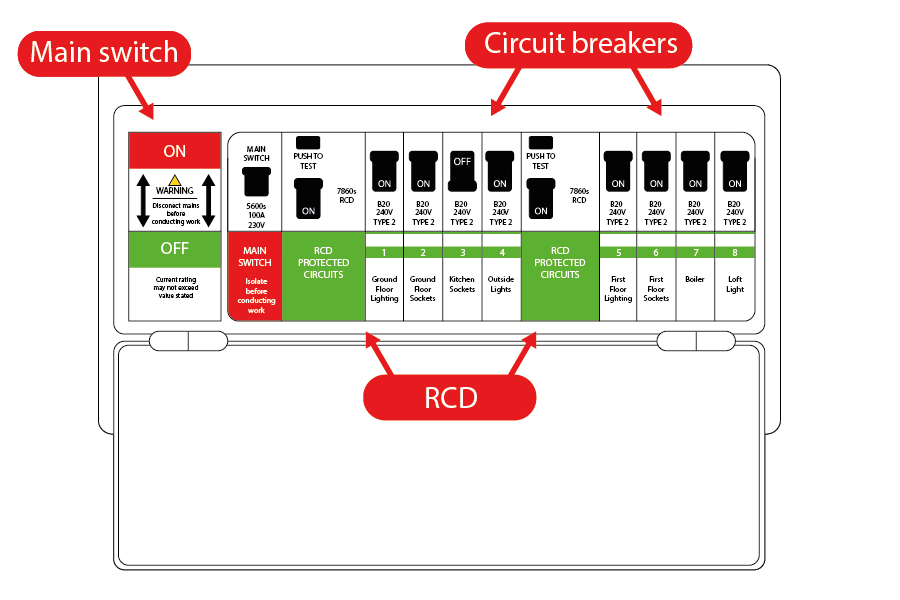
2. Check your circuit breakers to see which ones have tripped
When you look at your fuse box you’ll notice that one or more of the switches are down in the “off” position. Usually, each switch will have a label, so you should be able to tell straight away where in your home it’s linked to.
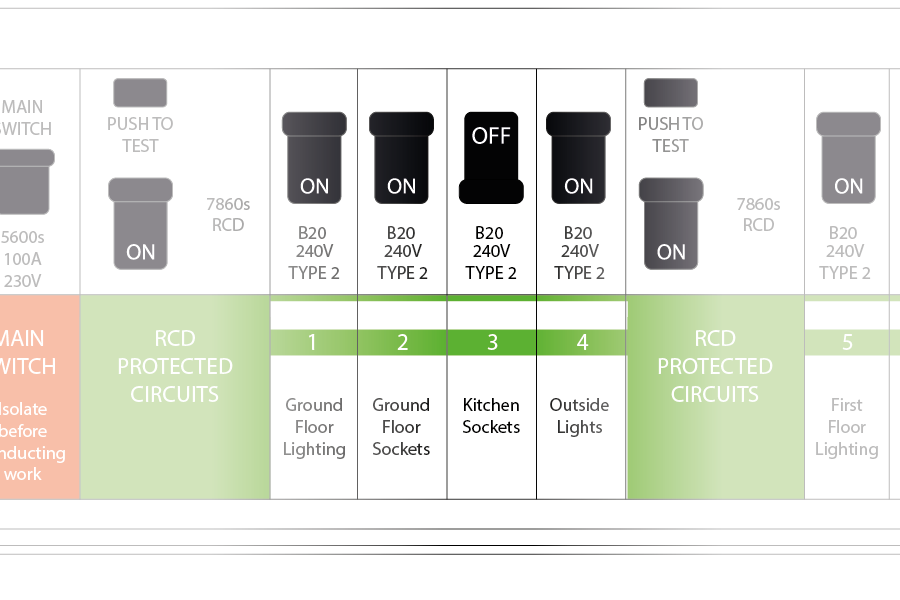
3. Flip tripped switches back up
If they are all up, your Residual Current Device (RCD’s) may be down so make sure they’re up too.
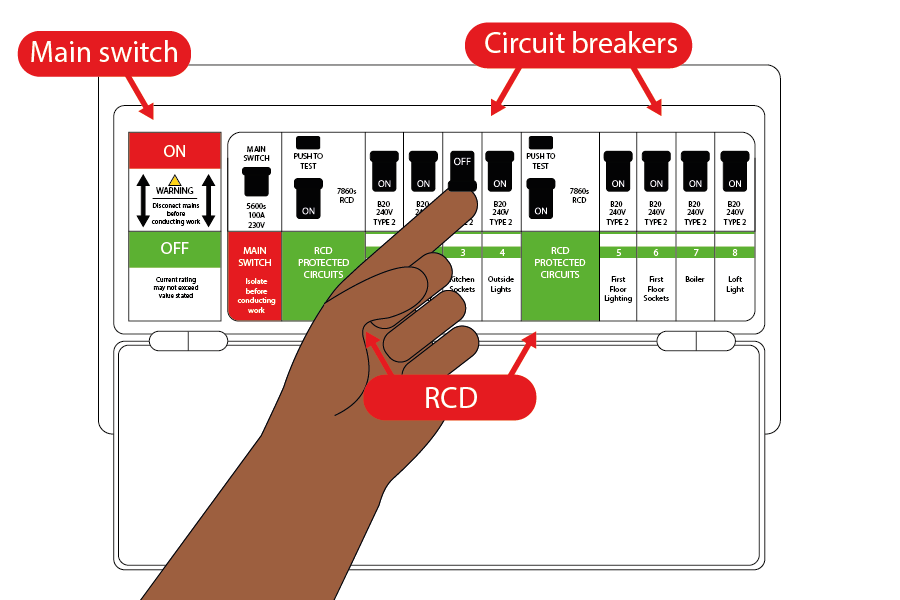
4. Power on!
This should mean that your power is now back on – if your switches don’t stay up then please continue to the next section.
Top tip 💡: If none of the switches are down when you inspect your fuse box it may mean you’ve had a power cut. Check with your neighbours or your energy provider – you can also take a look at our guide on what to do in a power cut .
What is an RCD?
An RCD, or Residual Current Device to give it its full title, is an important safety feature for your home.
In short, an RCD keeps you safe against injury and death by electric shock by detecting an imbalance between the outgoing and incoming total electrical current within a given number of circuits.
It works on the understanding that if there’s a difference in the electricity coming in against electricity going out, then the electric must’ve gone somewhere. This is what is known as a ‘residual current’ or ‘earth leakage’.
So if you’re doing some DIY and accidentally cut or drill through a cable, your RCD will kick in so that the electricity stops before it gets to you, meaning the circuit will break and you’ll stay safe.
What if the trip switch on my fuse box won’t stay up?
In most cases, there’ll be a simple explanation as to why your circuit breaker or RCDs keep tripping. Usually, tripped fuses can be tracked to their location within the home and you’re then able to work out what appliance was causing it to trip.
However, if you find that your mains switch keeps tripping then you may discover that the problem is with the fuse box itself. If this is the case, you’ll need to find a qualified electrician to look at this for you.
Which appliances can trip your fuse box?
There’s a number of reasons why your fuse box might trip, the most common ones include:
- An overloaded circuit – if you have too many appliances running off one circuit
- Too many appliances being used at the same time
- A faulty or misused appliance
- Overfilled kettles
- Unclean toasters
- Cooker rings worn out or cracked
- Faulty immersion heaters
- Faulty connections on leads to appliances e.g. televisions or stereos etc.
- Light bulbs blowing
How to find out what is tripping my electric
The safest and easiest way to find out what’s tripping your electric is to follow the same steps in the how to fix a tripped fuse section and follow these 3 steps to locate the appliance:
1. Identify the appliances or devices that are connected to the tripped circuit
Once you have located the tripped fuse, you’ll find it much easier to identify which appliances are connected to that circuit.
Hopefully, this means you’ll be able to check labels, head to that area of your home and match them up to the appliance or device in that space. Failing that you may need to trace the wires to the appliances or devices on that circuit.
2. Unplug or turn off the appliances or devices that are connected to the tripped circuit
To determine which appliance or device is causing your electricity to trip, you can unplug each one so you can find which one is causing the problem.
3. Reset the circuit breaker
Once you’ve unplugged all of your appliances you can then switch the fuse box to “on” and individually plug in and switch each appliance back on to troubleshoot which one is causing the fuse to trip.
Get peace of mind with HomeServe electrics cover
If you’ve tried all of the above and your fuse box continues to fail, then you may be interested in our guide on why a fuse box keeps tripping for some further guidance.
It may be that you think your fuse box needs the eye of a specialist either as a one-off repair or making a claim as part of your policy . Or, you may want to look at protecting your fuse box in case of an emergency, in which case you can take a look at our home electrics cover options .
- What is an air source heat pump and how do they work?
- How much do solar panels cost?
Sam Starbuck
Biography: After an early and varied career, including serving in the Falklands and also working as an active firefighter, Sam began his journey as an electrician in the 1990s as an apprentice with Bowdens Electrical contractors. Since becoming qualified in 1995, Sam has worked on a broad range of electrical repairs and installations, including caravan site supplies, wiring of new build houses, and response to out of hours calls. His experience extends to both domestic and commercial projects, including working on electrical installations in large businesses such as shopping centres, residential homes, street infrastructure and many others. Since joining HomeServe in 2018, his role has changed from being ‘hands on’ to a more knowledge and research based position within the Technical Governance Team, ensuring the business operates in a way that meets, or surpasses, industry regulations and standards. “I thoroughly enjoy working with HomeServe and almost every day brings a new challenge.” He loves spending time with his bulldog Bert, sailing his yacht or walking in the countryside. Qualifications: Institute of Engineering & Technology-technician member, Institute of Engineering & Technology member. Solar PV Systems installation & inspection, City & Guilds 2382, City & Guilds 2330, City & Guilds 2391, City & Guilds 2377, City & Guilds 2377-1, Tetra Working at Height, Tetra Restraint Equipment Inspection, Tetra Electrical Equipment Inspection, LCL Electric Vehicle Charging Systems, I.O.S.H. Management Years qualified: Since 1995

Leave a Reply Cancel reply
Your email address will not be published. Required fields are marked *
Save my name, email, and website in this browser for the next time I comment.
Privacy Policy Agreement * I agree to the Terms & Conditions and Privacy Policy .
Recent Posts
- How to read a smart electric meter
- How much does it cost to charge an electric car?
Want to ensure that your home is always running smoothly?

Living is your place to learn and explore. Whether it's inspiration for your new kitchen, how to bleed a radiator - or even a few things to keep your little one's busy. Living is here to keep your life moving!
- Privacy and Cookies
- Read our Disclaimer
© 2019 HomeServe .
Login to your account below
Fill the forms bellow to register
Retrieve your password
Please enter your username or email address to reset your password.
Find a local trusted trader
Search by trader name
What To Do If: Your Fuse Keeps Tripping
Electricity is one of the basic essentials in our homes, coming before almost anything else. If a fuse goes, it can be frustrating, but it helps to know what to do and when to call an electrician.
Causes of tripped or blown fuses
Finding out the cause of a tripped or blown fuse usually involves a process of elimination and a little patience. Most common causes are:
- Too many appliances plugged in
- A faulty appliance
- An appliance that is not maintained or is used inappropriately (e.g. overfilled kettle)
- Faulty immersion heaters
- Blown lightbulb
- Worn cooker rings.
If a fuse goes…
If a fuse goes, head straight to your fuse box, which is near your meter. Hopefully, you will know where it is and how to access it already. Your fuse box will have either fuses or trip switches. If a fuse “blows” then you will have to replace it in order to regain power. Trip switches are a more modern alternative to fuses. Rather than the fuse physically breaking, the switch is tripped and the power circuit goes from “on” to “off”.
Reset the trip switch
If a trip switch has gone, you should easily be able to see which one is the problem as the lever will be in the down position (usually showing “off” in red). Simply push the switch back up, to show “on” in green. If the switch flips down immediately, that is a sign that you have a faulty appliance plugged in somewhere. This is where the fun starts!
Finding a faulty appliance
It is most likely that only one circuit has tripped.
- Make a note of the appliances that aren’t working and unplug each one. If you have an immersion heater, switch it off.
- Once everything is unplugged, flip the trip switch to ON. It should stay on this time.
- Now go around the house and plug in each item that you have unplugged.
- Keep plugging appliances in until the fuse trips again; you have identified your culprit!
- Keep the faulty appliance unplugged (you can switch the trip back on now) and take it to a nearby electrical specialist for repair.
If the faulty item has a plug, it is worth changing the fuse in the plug before you take the appliance to be repaired. Replacing a fuse is not dissimilar to changing a battery. Unscrew the cover and look at the fuse in the plug already, or check the rating on the plug to find out what fuse you need. Once you know what fuse to use, it is a case of removing the old fuse, and popping a new one in.
While it is fine to attempt to do a range of home repairs yourself, when it comes to electrical faults, it is best left to the professionals. If you need to find an electrician, check out Trust A Trader’s directory of local trusted electricians . For more tips and advice, follow us on Facebook or Twitter .
Was this useful?
- Share on Facebook
- Share on Twitter
Electricians for Home & Business
07984363052 out of hours
01582550285.
- Nov 8, 2023
Electrical Blog - Troubleshooting Tripped Fuses: A Guide to Handling Electrical Issues
Electricity is a fundamental necessity in our homes, and when a fuse trips, it can be both frustrating and disruptive. Knowing how to handle this situation is crucial, as it can save you from unnecessary inconveniences and potential hazards. This article provides insight into what causes fuses to trip and offers a step-by-step guide on how to address the issue.
Common Causes of Tripped or Blown Fuses
Understanding the root causes of tripped or blown fuses is the first step in resolving the issue. Here are some common culprits:
Overloaded Circuits: Too many appliances plugged into a single circuit can overload it and cause the fuse to trip.
Faulty Appliances: An appliance with a malfunction or defect can trip a fuse.
Improper Appliance Usage: Using an appliance inappropriately, such as overfilling a kettle or running it beyond its capacity, can lead to a fuse tripping.
Faulty Immersion Heaters: Malfunctioning immersion heaters can also be a source of trouble.
Blown Lightbulbs: A blown lightbulb can sometimes trigger a fuse to trip.
Worn Cooker Rings: Worn-out or damaged cooker rings can overload the circuit.
What to Do When a Fuse Trips
Locate Your Fuse Box: Your fuse box, usually located near the electricity meter, is the first place to go when a fuse trips.
Identify the Problem: Examine your fuse box to determine whether it contains fuses or trip switches. In modern installations, trip switches are often used. A tripped switch shifts the power circuit from the "on" position to the "off" position.
Reset the Trip Switch: If you have trip switches, it's relatively easy to identify the problem. The tripped switch will be in the "off" position, usually indicated by the color red. Simply push it back up to the "on" position, typically shown in green. If the switch immediately flips back down, it's an indicator that a faulty appliance is connected to the circuit.
Identifying a Faulty Appliance
Unplug All Appliances: Start by unplugging all appliances connected to the circuit. If you have an immersion heater, ensure it's turned off.
Reset the Trip Switch: After everything is unplugged, reset the trip switch to the "on" position. It should remain on this time.
Plug in Appliances One by One: Gradually plug in each item that you've unplugged. Continue this process until the fuse trips again, at which point you've identified the problematic appliance.
Address the Faulty Appliance: Keep the faulty appliance unplugged and take it to a nearby electrical specialist for repair. If the faulty item has a plug, consider changing the fuse in the plug before getting it repaired. This is a straightforward process similar to changing a battery.
By following these steps, you can efficiently troubleshoot and resolve a tripped fuse, ensuring a safe and functional electrical system in your home. Remember, electrical issues should always be approached with caution, and if you're unsure, it's best to seek professional assistance to ensure your safety and that of your property.

Recent Posts
Electrical Blog: Safeguarding Lives: A Deep Dive into Electrical Safety Standards and Practices in the UK
Electrical Blog: Evaluating the Electrical Needs of a Home Office Setup in the UK
Electrical Blog: Is It A Good Idea To Install USB Sockets?.

Fuseboxes Explained
A fusebox, also sometimes known as a consumer unit, should be easy to find and is where the electricity in your home is controlled and distributed.
Find an electrician
We recommend that you use an electrician registered with one of the government-approved schemes
It’s important that you know where your fusebox is in case you ever need to turn the electricity off in an emergency. It contains three things – the main switch, fuses and/or circuit breakers, and Residual Current Devices.
A) Main Switch – this allows you to turn off the electricity supply to your home. You might have more than one mains switch, for example if your home has electric storage heaters. In this case you may have a separate fusebox.
B) Residual Current Devices (RCD) these are switches that trip a circuit under dangerous conditions, and instantly disconnect the electricity.
For more on RCDs please click here .
C) Circuit Breakers – these are automatic protection devices in the fusebox that switch off a circuit if they detect a fault. They are similar in size to fuses, but give more precise protection. When they ‘trip’, you can simply reset the switch. But make sure you correct the fault first.
Fuses (may be found in place of circuit breakers) – rewirable fuses have a piece of special fuse wire running between two screws. When a fault or overload current flows through the fuse wire, it will become hot and melt. The melted fuse breaks the circuit, disconnecting the faulty circuit and keeping you safe.
If you are concerned that your fusebox may need replacing, always consult a registered electrician .
Share this article:
(912) 602-3068 | Need Power? Call Clocktower!

(912) 602-3068
How to Fix a Tripped Circuit Breaker That Won’t Reset
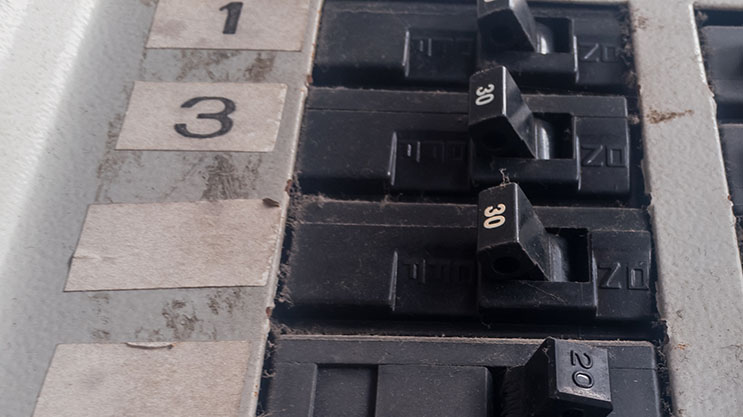
- March 26, 2024
- Electrical Tips
Have you ever had a circuit breaker trip and found that it won’t reset? It’s a common problem, and one that can be frustrating when you’re not sure what to do.
The most common reasons for a circuit breakers that won’t reset are:
- Damaged breakers
- Electrical shorts
- Loose wiring
- Damaged insulation
In this post, we’ll walk you through how to check for each of these common reasons, and discuss how to fix them.
Why circuit breakers trip
A circuit breaker is a safety device in your home designed to stop the flow of electricity if there’s an overload, which can help prevent fires. When the current flowing through the circuit breaker becomes too much for it to handle, it “trips” and shuts off the power to prevent a fire from starting.
Most of the time, resetting a tripped circuit breaker is a simple matter of flipping the switch back to the “on” position. However, sometimes the breaker won’t reset no matter how many times you flip it.
First, try to reset the tripped circuit breaker
First, we should perform a basic test to make sure the breaker is actually malfunctioning. If you haven’t already tried manually resetting the circuit breaker, this is the place to start.
Locate your circuit breaker box and open the cover. Once you’ve located the tripped breaker, flip it to the “Off” position. Then, flip it back to the “On” position. You should hear a click as the breaker resets. If the breaker trips again, or simply won’t reset, there may be a problem with your wiring.
How to fix a tripping circuit breaker
Check to see if the circuit breaker is damaged.
If the circuit breaker trips and won’t reset, the first thing you should do is check to see if the switch is damaged. Circuit breakers are designed to trip when they become overloaded, which means they’re also designed to be flipped back on when the overload is resolved. However, if the switch itself is damaged or the electrical panel is outdated , it may not reset properly.
To check for damage, first make sure that there’s no power going to the breaker box by flipping all the switches to the “off” position. Then open up the panel and visually inspect the faulty breaker for any signs of burned or blackened areas. If you see any charring or burning around the switch, it’s likely time to replace it.
In some cases, you may be able to reset a damaged breaker by gently bending the switch back into place. However, this is only a temporary fix and the breaker will eventually need to be replaced.
We recommend that if you see any damage, it’s best to replace the entire circuit breaker rather than just the switch.
Check to see if there’s an electrical short
Another reason why your circuit breaker won’t reset after tripping is because there’s an electrical short somewhere in your home. An electrical short occurs when there’s too much current flowing through a wire, causing it to overheat and potentially start a fire.
To figure out if there’s an electrical short, the first thing you should do is turn off all of the switches in your breaker box. Once everything is off, go around your home and look for any signs of an electrical fire, such as burning smells or smoke. If you see or smell anything suspicious, call a licensed electrician right away.
If you don’t see any signs of a fire, the next step is to identify which circuit is causing the problem. Start by flipping on one switch at a time and seeing if the breaker trips. If it does, leave that switch off and move on to the next one. Repeat this process until you’ve found the problem circuit.
Once you’ve identified the problem circuit, the next step is to figure out where the electrical short is located. The easiest way to do this is to start at the breaker box and work your way down the circuit until you find the problem.
If you’ve followed these steps and you believe there may be an electrical short, it’s important to call an electrician right away. They’ll be able to locate the source of the problem and fix it before it causes any further damage.
Check for loose wiring
Another common reason for a circuit breaker to trip is because of loose wiring. Over time, wires can loosen and become frayed, which can cause them to short circuit.
The best way to check for loose wiring is to listen to your devices and appliances for the sound of buzzing or crackling. One common culprit is buzzing light switches or outlets. If you don’t find a faulty appliance, note that this can also be true around the breaker.
If you hear these noises and suspect that your circuit breaker is tripping because of loose wiring, the best thing to do is call an electrician as soon as possible. Trying to fix the problem yourself could result in injury or even death.
An electrician will be able to quickly diagnose the problem and make the necessary repairs. In most cases, they’ll also be able to prevent the problem from happening again in the future.
Look for signs of corrosion
Another common reason for a circuit breaker to trip is corrosion. This is especially true if you notice any moisture or wetness in the electrical panel . Corrosion can cause the metal parts of the breaker to break down, which in turn can cause a short circuit.
Corrosion usually appears in the form of a white, chalky substance building up around screw terminals. Look for signs of corrosion, rust, or moisture around the circuit breaker.
If you suspect that corrosion is the culprit, call an electrician to have a look at the problem. Trying to clean or repair the corrosion yourself could result in serious injury.
Check for damaged insulation
Sometimes circuit breakers will have insulation around them to stop cold air from entering through the box itself. Damaged insulation is another common cause of tripped circuit breakers. If you have insulation around the box, inspect it to see if it looks damaged.
If the insulation around your electrical wiring is damaged, it could cause a short circuit. Once again, if you suspect that this is the problem, call an electrician rather than trying to repair the problem yourself.
Is it dangerous if a circuit breaker keeps tripping?
We are often asked if tripping circuit breakers are dangerous. If your circuit breaker keeps tripping, it could be a sign of an electrical problem in your home, up to and including serious fire risks. While it’s not necessarily dangerous if your circuit breaker trips occasionally, if it happens frequently, it should be fixed right away.
If your circuit breaker trips and won’t reset, don’t panic! Many times the problem is something minor that you can easily fix yourself. However, if you’re unsure of what to do or think the problem may be something more serious, always err on the side of caution and call an electrician . Trying to fix the problem yourself could result in serious injury or even death.
Resetting a tripped circuit breaker is a relatively simple process that most people can do on their own. However, if the breaker trips repeatedly or if you have any questions about your electrical system, it’s always best to contact a professional electrician for assistance.
If you have any questions about resetting your circuit breaker or if you need assistance from a professional, don’t hesitate to contact us . We’re here to help!
Latest Articles
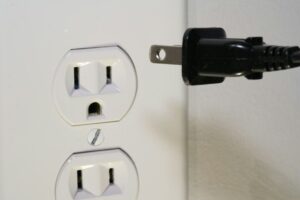
Why Would An Outlet Stop Working? Top 7 reasons, and their solutions

Average Electrician Cost to Install an EV Charger

Light Switch Buzzing: Causes, Dangers, and Fixes

How Many Things Can I Plug Into One Outlet Safely?
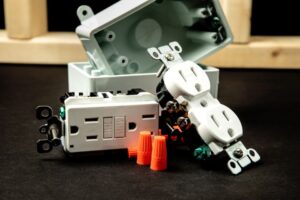
Commercial Outlet Vs Residential Outlets: Which is Right for You?

Are Ungrounded Outlets Dangerous? Understanding the risks

Copyright © 2023 Clocktower Electric, LLC. All rights reserved. St. Simon’s Island, GA 31522
Contact Us | Privacy Policy | Site Map
24/7 EMERGENCY Call Out

- Emergency Electrician - 24 Hour Call Out
- Electrical Fault Finding
- Electrical Installations
- Fuse Board Replacements
- Complete Rewiring
- Lighting & Power
- Smart Home & Security
- Smoke, Fire & CO Detectors
- EV Charging Point Installations
- Electrical Inspection & Reports
- Portable Appliance Testing
- Repairs & Maintenance
How to Fix a Tripped fuse or switch – An Electrician’s Guide
Fixing a tripped fuse or switch : an electrician’s guide.
Dealing with a tripped fuse or switch can be a hassle, but it’s a common issue that every homeowner faces. Whether it’s caused by an overloaded circuit, a power surge, or a faulty appliance, knowing how to address this problem can save you time and stress. In this blog post, we’ll guide you through the process of diagnosing and fixing a tripped fuse or switch. With our step-by-step instructions and safety tips, you’ll be able to restore power to your home quickly and safely. So, let’s get started on turning those lights back on and getting your appliances running smoothly again.
Identify the Problem
To address a tripped fuse, you should first identify and correct the underlying cause. There are two fuseboard types and working on them have unique approaches. In this article are some details on fuse box types and how to address the problem for each. If you’re unsure or uncomfortable dealing with electrical issues, it’s advisable to contact an electrician .
Note: Do not attempt to resolve tripped switches or fuse boxes if you are uncertain about the cause.
Fuse board types
There are two main fuse box types basically we have the old school fuse boxes and the modern fuse boxes also now widely known as consumer units or fuse boards.

Differences between Old fuse boxes and Consumer Units
Old fuse boxes have fuses that blow up should there be an anomaly in your electrical system and require a manual replacement. Now with these modern consumer units, the switches go off immediately there is a fault, with no smell of burnt fuse and noise of fuses blowing up. And that is why it is the modern world.
In both cases you will have to identify the underlying cause as mentioned earlier before attempting to replace fuses or put the switches back on.
What anomalies cause the switches to trip or fuses to blow?
- An overloaded circuit
- Too many appliances being used at the same time.
- A faulty or misused appliances
- Faulty immersion heaters
- Faulty connections to appliances e.g., televisions or stereos etc.
- Light bulbs blowing
- Short circuits
- Ground faults
- Loose Wiring
- Old or Damaged Wiring
- Faulty Circuit Breaker

How to fix tripped switches on Consumer units?
To fix a tripped switch on new consumer units,
First open the fuse board and check to see if any of the switches are off. Use the indicators on the switch or the fuse box to determine that. In most cases, the switch facing upwards means “ON” and it facing downwards means “OFF”. Turn all those off back on and if it does not stay on, you probably have another issue to resolve or the underlying issue was not fixed properly.
How to fix tripped fuse on Old Fuse box?
To fix a tripped fuse on an old fuse box,
- Turn off the power source.
- Take out the blown fuse and insert a replacement.
- Then switch the power back on.
To find the right replacement it is best you send the blown fuse along when getting a new one if you don’t understand much about electrical writings.
Tip: If a fuse or switch trips, unplug some devices on the affected circuit before resetting it. Overloading is a common cause, so reducing the load can help prevent future trips. If the issue continues, it may indicate a more serious problem needing help from experts .
What to do if the switch goes back off after switching it on?
Should you face the challenge of the switch not staying on it means one or some electrical appliances have a fault. You can narrow down on what is causing it by turning off all the switches and turning them on one by one to see which part of your property does not have functioning electrical systems. You can also just go around the house and see what appliance stopped working. Either way you will know exactly what is causing the issue and you may need to call on qualified electricians to come to your rescue.
Was this article helpful?
Share this post, related posts.

Electrical Panels | Common Issues & Solutions

- 24 Hour Emergency Electrician
Book an Electrician
- Electric Vehicle Charging
- Smoke Alarms, Fire & CO Detectors
- Accreditations
Start typing and press enter to search
To make a booking with us, please describe the problem you are having in the short form below., request a callback, send us your details, and we'll do the rest..
What to Do if Your Circuit Breaker Won’t Reset?
Written by: Author Andrew Helling | Reviewed by: Editorial Team
Posted on Last updated: February 14, 2024
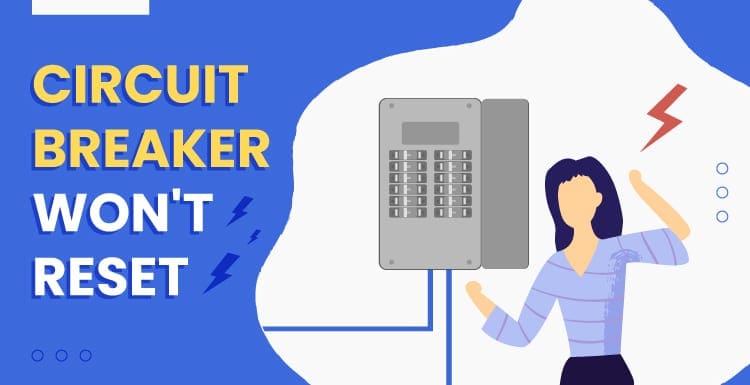
Are you wondering why your circuit breaker won’t reset?
This is a common problem. But it can get dangerous very quickly.
We suggest you call an electrician, but if you have DIY experience, there are some things to try.

We partnered with Networx to help you find local electricians. Click to below to get a FREE quote.
Circuit Breaker Won’t Reset?
Did you notice that your tripped circuit breaker won’t reset?
We’ll help you determine the cause of your problem. After all, there are several reasons a circuit breaker won’t reset.
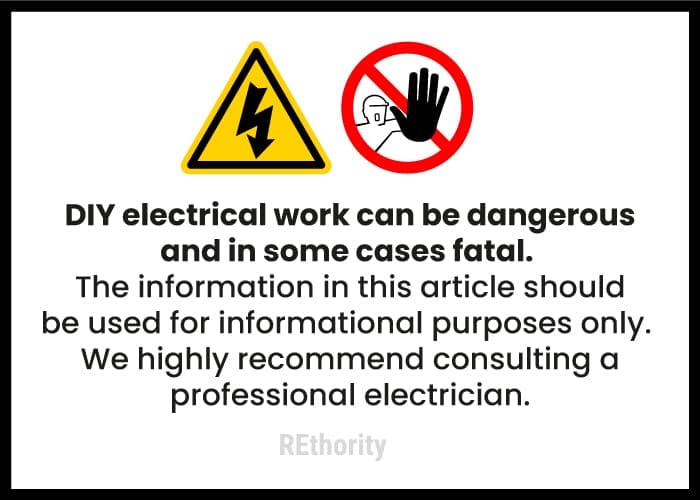
Some can indicate dangerous electrical problems.
In this article, we’ll explain:
- Different reasons your circuit breaker won’t reset
- When it may be safe to fix the problem
- And when to call a professional
But first, we need to get something out of the way. First, our guides are for informational purposes only.
We’re not licensed electricians, so we think you should always consult a professional. If you don’t take the right precautions, damage, fire, injury, or even death could result.
That said, in this article, we’ll explain the eight different reasons your breaker won’t reset, tips on when it may be safe to fix the problem yourself, and when to call a professional.
DIY vs Calling a Pro

Even without advanced electrical knowledge and safety training, you may still be able to fix simple issues that lead to your circuit breaker failing to reset. Some of the underlying problems are more complex.
They may involve potentially dangerous contact with electrical wiring. These are the issues that will require a professional’s expertise. Again, messing with electricity without training is dangerous.
Whether you plan to fix it yourself or call a professional, it’s worth reading through the troubleshooting steps to learn about common ailments.
This way, if you call an electrician, you can provide them with additional information and get the problem fixed sooner. This will save the electrician time and you money.
Need a Local Electrician?
You probably don’t have a go-to electrician in your area. That’s understandable because, with any luck, you don’t need their services too often.
It does make it harder to find an electrician in the area when an electrical problem comes up, and you need someone to fix it fast.
That’s where we come in. Click here to describe the problem you’re having and get a free quote from a licensed electrician in your area right now!
Why Did the Circuit Breaker Trip in the First Place?
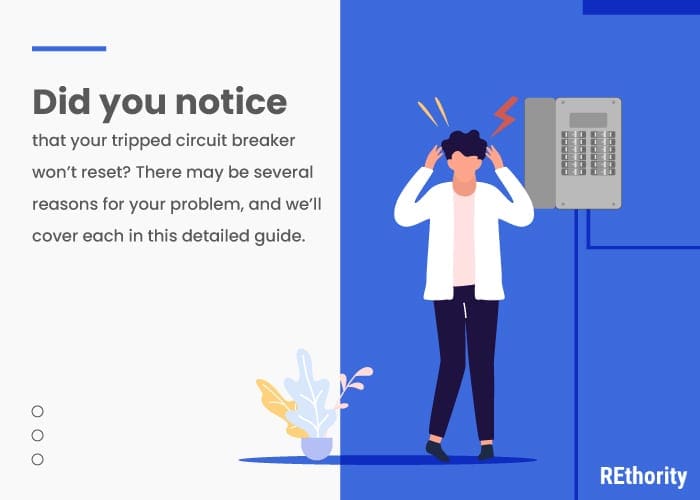
Circuit breakers are electrical safety devices for our protection. They ensure that the current moving through the wiring in our homes and buildings doesn’t rise to dangerous levels capable of causing overheating, property damage, or a fire.
Circuit breakers do this by limiting the current that passes through a circuit to an acceptable level. Current is measured in amperage.
The gauge, or size, of each circuit’s wiring decides how many amps and how much power will be safe to flow through that circuit.
Overloaded Circuits
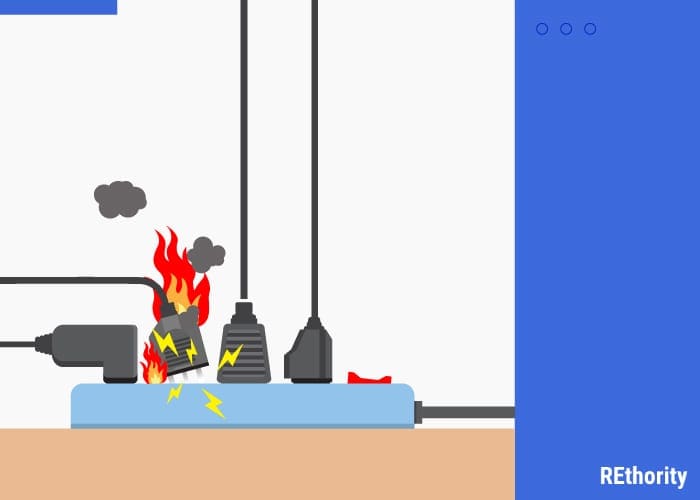
If too much electrical power flows through the wires in a circuit, the overload of electricity causes the circuit breaker to trip and break the circuit. This prevents additional damage from happening.
For example, most outlets and fixtures in a home are rated as either 15 amps or 20 amps.
- If the wire size used on a circuit is 14 gauge, it’s a 15 amp circuit. This means up to 15 amperes of current (1,800 watts) can safely flow through the outlets and fixtures on that circuit. Any more than 1,800 watts, and the circuit breaker will trip to break the circuit.
- If the wire size used on a circuit is 10 or 12 gauge, it’s a 20 amp circuit . This means up to 20 amperes of current (2,400 watts) can safely flow through the outlets and fixtures. Any more than 2,400 watts, and the circuit breaker will trip to break the circuit.
Anytime the number of watts (the measure of electrical power) being used goes above the circuit’s amp rating, the breaker will trip.
Here are some common reasons a breaker might trip:
- Plugging in too many devices or lights on one circuit
- Plugging in a device that pulls more power than you usually use (like power tools or a new TV)
- Connecting two or more extension cords to one circuit
- A short circuit creates a sudden spike the flow of current through a circuit
Once the circuit breaker trips, the circuit is broken. It must be manually reset to allow the current to flow again.
Circuit Breaker Won’t Reset: Troubleshooting the Problem
You’ll know that your circuit breaker has tripped if you suddenly lose power in part of your home. You might have experienced something like this:
You’re watching TV when it suddenly shuts off, along with nearby lights , ceiling fans , and everything else plugged in. You think that the circuit breaker has tripped, so you head to the electrical panel to reset the breaker.
You push the tripped switch into the off position, then back up into the on position to reset it. But the switch won’t stay in the on position, and the circuit breaker won’t reset.
Or it resets but trips again immediately. If something similar happened and you couldn’t reset the breaker, there are a few things that could be the culprit.
We’ll start with the simplest ones, then move on to problems that will require a professional’s help.
The Circuit Breaker Switch Isn’t Fully Off
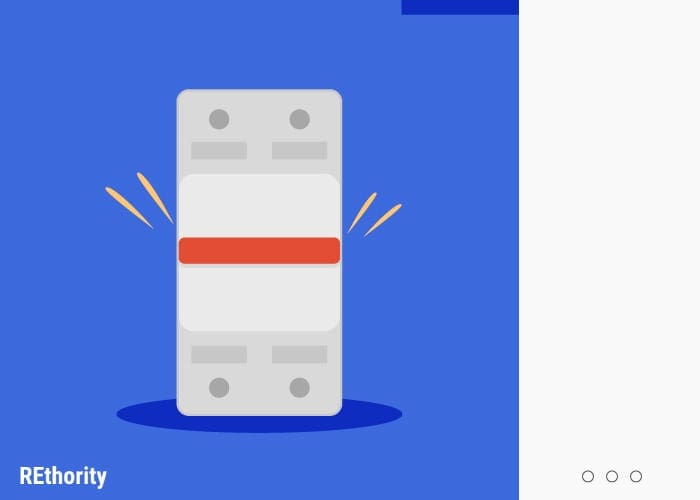
Be sure to click the tripped breaker switch into the off position firmly. From the tripped position, the switch has to move into the off position before it can be reset by switching it into the on position.
If you’ve been trying to push it into the on position without turning it off first, this could be the reason your circuit breaker won’t reset.
What you can do: Push the tripped switch back toward the off position until you hear a click. Push it forward to the on position.
If this was the extent of the problem, it should stay in the on position and not “bounce” back into the tripped position.
You Reset the Wrong Circuit Breaker Switch
Many times, the switches on circuit breakers will be labeled incorrectly or not at all. If it’s difficult to see your panel, you may have been resetting the wrong switch.
What you can do: With a flashlight, examine the switches to find one that looks like it’s not in line with the others. A tripped switch will look like it’s halfway between the on and off positions.
Remember to pull the switch back toward Off until you hear a click, then forward to On.
The Circuit Is Overloaded
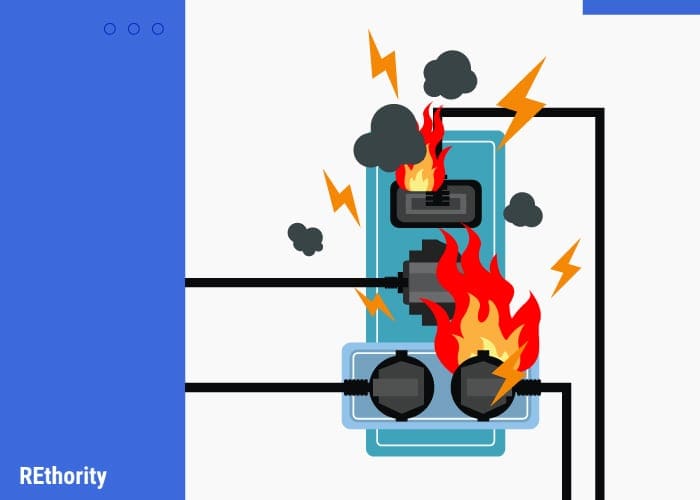
Circuits get overloaded when the electrical load is too high. Usually, this is due to too many devices or appliances being plugged in and using power.
It could also be due to a faulty appliance that is drawing more power than it should. You’ll know it’s an overloaded circuit if this happens:
- The breaker trips and you can’t get it to reset
- After letting it cool down for a few minutes, you’re able to reset it
- The breaker trips again a few minutes later
What you can do: If it is an overloaded circuit, it’s safe for you to fix yourself. Just unplug every device and appliance on that circuit, then try to reset the breaker again. If it works this time, you’ll know the circuit was just overloaded and throwing the switch.
As you plug devices back in one by one, see if an obvious culprit is drawing too much power. Try to move devices to other circuits to reduce the electrical load on the affected circuit as well.
There’s a Short Circuit
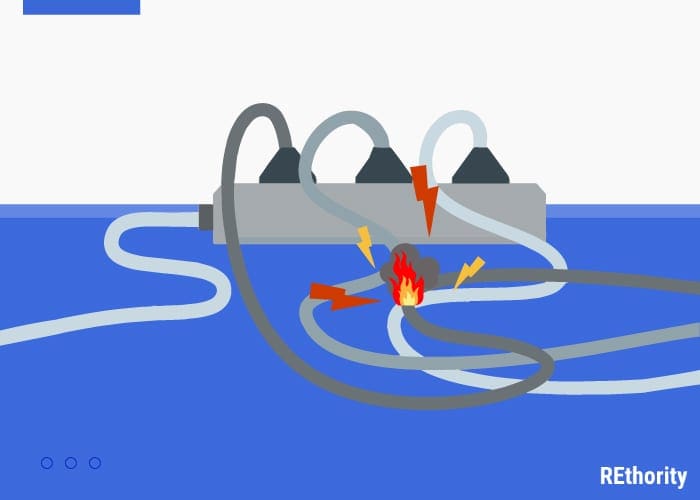
A short circuit happens when two electrical wires that aren’t supposed to touch come into contact. The electricity flowing through the wires surges and floods the circuit with additional current.
This trips the circuit breaker. Short circuits can happen in appliances, outlets, or switches. The wires touching in a short circuit may just be loose.
They could also be the result of damage from rodents or other animals chewing through them. It could be a short circuit if this happens:
- The breaker trips when you plug a certain appliance or device in
- It trips when you plug something into a certain outlet
- The breaker trips when you turn on a certain switch
- When you reset the breaker, it immediately trips again
What you can do: You’re going to need a professional for this one. Short circuits involve hot wires that have extremely high levels of current flowing through them. This presents a huge risk of getting shocked.
However, you can get an idea of the short circuit’s location (appliance, outlet, or switch) with a few simple tests before the electrician or appliance repair technician arrives.
- If there’s an appliance you suspect may have a short, try plugging it into a different outlet. If it immediately trips the breaker, you’ll know the appliance is the problem. Unplug it immediately, and don’t use any appliances with a short. An electrician or appliance repair technician will need to fix the problem.
- If a certain outlet seems to be the short-circuit location, try plugging something into the outlet to see if it trips the breaker. An immediate trip would indicate the short is in the outlet. Unplug the device, and don’t touch the outlet. An electrician will need to fix the problem.
- If you think a switch is where the short is, flip it on again to see if it trips the breaker. If it does, you’ve found the problem. Flip the switch off and don’t use it until an electrician can repair the problem.
Faulty or Blown Circuit Breaker
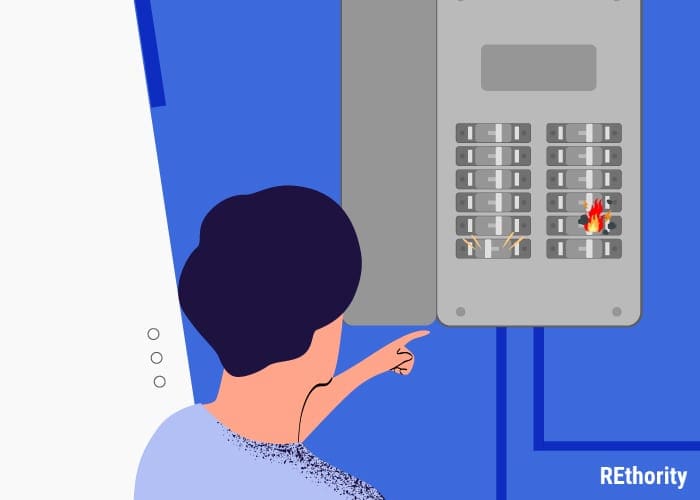
A faulty or blown circuit breaker can cause a switch to stay in the tripped position no matter which way you push it. It’s not usually the culprit when a circuit breaker won’t reset.
But it’s such a serious problem that it’s worth having an electrician come to inspect just in case. Your circuit breaker is a safety mechanism to protect you and your home from damage from electrical problems.
One that’s not operating correctly isn’t offering protection. You might suspect a faulty or blown circuit breaker if:
- You push the tripped breaker switch toward the Off position firmly
- It springs back to the middle-tripped position
What to do: Call an electrician right away. Your circuit breaker will probably need to be replaced. You are at increased risk for damaged wiring, appliances, and electrical fires without a properly working circuit breaker.
Whatever you do, never replace the circuit breaker with one that has a higher voltage rating. These breakers can cause the wiring in your home to overheat, which could cause a fire.
Other Reasons a Circuit Breaker Won’t Reset

- Open ground: Outlets and wires have an “open ground” when a wire isn’t correctly grounded. It usually happens when a wire is disconnected on one end, and it will affect all the outlets connected from that point in the house. This is a type of short circuit and is very dangerous, so call an electrician immediately to fix it.
- The electrical overload in the circuit is still there. If you failed to unplug appliances and devices from outlets using the circuit that tripped the breaker, the electrical overload is still there. It may prevent you from resetting the breaker, so unplug those appliances and devices and try to reset them again.
- GFCI (Ground Fault Circuit Interrupter) wasn’t reset. Circuits that have a GFCI need to be reset either individually or in the main electrical panel. Unplug any devices from GFCI outlets (they have Test and Reset buttons) and then push Reset. Some electrical panels have a GFCI breaker switch that usually features a test button. If resetting the outlets doesn’t fix the problem, try resetting the GFCI breaker switch.
Frequently Asked Questions
How do you fix a circuit breaker that won’t reset.
If your circuit breaker won't reset, push the tripped switch back toward the Off position until you hear a click.
Push it forward to the On position. If that doesn't work, with a flashlight, examine the switches to find one that looks like it’s not in line with the others. A tripped switch will look like it’s halfway between the On and Off positions.
If it is an overloaded circuit, it’s safe for you to fix yourself. Just unplug every device and appliance on that circuit, then try to reset the breaker again.
If it works this time, you’ll know the circuit was just overloaded and throwing the switch.
How do you reset a stuck circuit breaker?
To reset a stuck circuit breaker, turn it all the way off and then back on.
If it trips again, your circuit may be shorting out or it might be overloaded. In that case, call an electrician immediately.
What are the signs of a bad circuit breaker?
A few signs of a bad circuit breaker include flickering or blinking lights, poor performance of appliances, the need to regularly replace light bulbs, and smelling a burning odor from your electrical panel.

Under what condition might the circuit breaker not reset?
The most common reason a circuit breaker wouldn't reset is due to an overloaded or faulty circuit. However, both of these issues should be fixed by a licensed electrician.
Can a breaker be bad but not tripped?
Yes. A circuit breaker can be bad but not tripped. This needs to be fixed immediately, as a circuit breaker that doesn't trip could lead to an electrical panel fire.
Why Would a Circuit Breaker Stay Trip?
The most common cause of a circuit breaker tripping and staying tripped is overloaded circuits. If your breaker continues to stumble or stays tripped, you may need to shut the breaker off and back on, fully resetting it.
You might also have to shut off your appliances to give the breaker a chance to clear.
Alternatively, a breaker that stays tripped might be short-circuited or blown.
A blown circuit is likely to feel warm to the touch and won’t stay in reset mode. It might also have visible damage or a burning smell. At this point, your breaker will not reset on its own.
This means that your breaker will need the assistance of a qualified electrician to resume working.
How Do You Know if a Circuit Breaker is Blown?
There are several ways to tell if your circuit breaker is blown.
First, it may be blown if your breaker doesn’t stay in “reset” mode. If you notice a burning smell, that is not a good sign and may signal a short circuit.
You can feel the breaker to see if it is hot to the touch, and if you notice damage to the box or outlets, you may have a short-circuit situation on your hands.
Lastly, if your breaker is old, consider replacing it since old breakers are more likely to give out.
When a Circuit Breaker Won’t Reset, Put Safety First

Some issues around the house are easy to fix without help, but anything involving electricity just isn’t worth the risk. If your circuit breaker won’t reset, there are two things you should do.
First, double-check to make sure you’ve tried to reset the breaker switch correctly (and that you’re resetting the right one). Then, unplug any devices and appliances from an outlet you think may be overloaded.
Don’t mess with suspected short circuits, faulty breakers, or ground faults at all. Just call a licensed electrician. They can help with any of the issues we’ve covered in this troubleshooting guide.
And they know how to do it safely and to code. Electrical issues should be addressed right away. Click the button above to get a free quote from a qualified, licensed professional near you today.

More results...
- Gas & Heating
- Handyman Service
- Appliance Repairs
- Loft Conversion
- Waste Removal London
- Join Our Standby List
- Pre-Book & Pay Less
- Special Offers
- Ask a Tradesperson
- New Supplier
- Complaints Procedure
- Get Our Software
- Case Studies
- For Business
- Get an Instant Quote
- Book On Demand
- Call 0208 059 8111
- Electrical Advice
How to Fix a Tripped Fuse: A Step-by-Step Electrician’s Guide
- March 22, 2024
- Blog , Electrical Advice

- What We Discuss Here
- - What Is The Difference Between a Fuse And a Breaker?
- - What Causes a Tripped Circuit Breaker?
- - What Causes a Fuse To Trip or Blow?
- - What If My Fuse Box Keeps Tripping?
- - How To Fix an Electrical Issue At Home?
- - Signs of a Tripped Fuse
- - How To Fix a Tripped Fuse?
- - Expert Tips to Prevent Future Trips and Blown Fuses
- - How Do I Know If I've Overloaded a Circuit?
- - Safety Measures
- - When to Call a Professional Electrician
At some point, all London homeowners and landlords will likely encounter the frustrating power cut-off of a tripped fuse. For many, the first instinct might be to call an electrician immediately.
But what if there was a simple fix you could perform safely and swiftly?
This guide will explain to you how to identify and reset a tripped fuse. By the end, you'll be equipped to handle this common electrical issue on your own, saving you time and money while enhancing home safety.
Well, Before we jump into the nitty-gritty, it's important to understand the difference between a fuse and a breaker in the first place.
What Is The Difference Between a Fuse And a Breaker?

13 Amp, 3 Amp and 5 Amp fuses in the UK

NXB-125 Moulded Case Circuit Breaker
The main difference is that fuses can't be used again, but breakers can be used many times. Breakers shield homes and devices from overloading and short-circuiting, while fuses only protect against overloading.
Both fuses and breakers stop the electricity flow, but they work differently. A fuse melts metal when it gets too hot, while a breaker switches off when there's too much electricity.
What Causes a Tripped Circuit Breaker?
The main reason a circuit breaker trips is when there's too much electricity (power surge), overloading the circuit because of too many lights, devices, or appliances using the same circuit.

The main breaker is on the right side, and the other breaker is on the left side.
What Causes a Fuse To Trip or Blow?

Fuses can trip or blow if you're using more electricity than the circuit can handle. This happens when you plug in too many devices or appliances at once, putting a strain on the electrical system.

Running too many appliances at the same time can overwhelm the circuit, causing the fuse to trip. This often occurs when multiple high-power devices operate simultaneously, drawing more electricity than the circuit can safely handle.

A defective or misused appliance can also lead to a blown fuse. If an appliance has a short circuit or a malfunctioning component, it can cause a surge of electricity that exceeds the capacity of the fuse, resulting in a trip.

Overfilling kettles or having dirty toasters can create electrical problems. When water or crumbs touch electrical parts, they lead to a short circuit, resulting in a blown fuse.

Worn-out or cracked cooker rings can cause electrical faults that trip the fuse. Over time, the heating elements in cookers can deteriorate, leading to increased resistance and potential overheating.

Faulty immersion heaters can also trip fuses. If the heating element becomes damaged or the thermostat malfunctions, the circuit can overload, causing the fuse to blow.

Faulty connections on appliance leads, such as those for TVs or stereos, can result in electrical issues. Loose or damaged connections can create resistance in the circuit, leading to overheating and fuse failure.

If light bulbs frequently blow out, it could indicate an underlying electrical problem. This could be due to issues such as voltage fluctuations, poor wiring, or incompatible bulbs, all of which can cause fuses to trip or blow.
Book a Serviceteam Electrician Today!
What If My Fuse Box Keeps Tripping?
Uh-oh! Lights out? Sockets dead? Fuse box acting up again? We understand your frustration! It's common for breakers to trip or fuses to blow occasionally, but if this happens frequently, there might be a larger problem at hand.
Fuses play a crucial role in electrical circuits, ensuring our safety. When a fuse trips, it's a warning sign that something might be wrong with an appliance or wiring in your home.

If you've followed the steps above and still can't figure out why your fuse keeps tripping or if it happens repeatedly, the problem might lie with the fuse box itself.
The fuse starts to break the circuit when the current is too high, preventing electrical damage and fires.
You can usually pinpoint the problem by elimination. If the problem persists, don't hesitate to contact Serviceteam Professional Electricians in London for a reliable service.
How To Fix an Electrical Issue At Home?
Here are some steps to help you troubleshoot electrical issues at home:
Look for any faulty or damaged items that may be causing problems. If you find any, unplug or replace them.
Look for signs of burning, discolouration, or unusual smells. Check for frayed or exposed wires. If you notice any issues, it's best to call a licensed and experienced electrician to assess and repair them.

Rodents like rats, mice, and chipmunks are known for chewing through electrical wires, which can lead to dangerous situations. If you suspect pests are present in your home, contact an exterminator to address the issue.

Make sure the breaker of the correct size is being used for each circuit. Ensure that all breakers are secure, and there are no sparks or signs of burning.
Here are some signs to look out for:
- The main breaker trips, but the individual breakers seem fine.
- The breaker won't reset properly.
- You notice a burning smell coming from the electrical box.
- The circuit breaker keeps tripping frequently.
- There are signs of damage to a breaker, such as scorch marks.
If you spot any issues, contact a licensed electrician for repairs. Remember not to attempt any electrical work unless you're completely confident in your abilities.
Always prioritise safety when dealing with electrical issues. If you're unsure or don't have the right tools, it's best to hire a professional electrician who can safely handle the situation.
Signs of a Tripped Fuse

How can you tell if you're dealing with a tripped fuse ? Look for a power shut-off in one area of your home, frequently accompanied by a loss of lighting.
In some cases, the fuse box might show a red indicator or the switch corresponding to the affected area will be in an 'off' position.
[The Step-by-Step Guide]
How To Fix a Tripped Fuse?

There is no need to panic when you discover a fuse box switch is tripped; just follow these simple steps.
Before attempting to reset the fuse, the first and most critical step is to switch off all appliances and lights connected to the circuit that you suspect is tripped. This helps prevent further overload and reduces the risk of electrical hazards.
Once everything is powered down, find your electrical panel. In most London homes, this is a grey metal box found in a hallway, basement, or other utility area. Knowing where your panel is located before an emergency is crucial so you can access it easily.
The first step in fixing a tripped fuse is identifying the problem. When a fuse trips, it's typically due to an overload or short circuit in the electrical system. Start by locating your fuse box, usually found in the basement, garage, or utility room. Open the fuse box, and you'll see a series of on-off switches known as circuit breakers. Each switch controls the electricity to a different part of your home and is labelled accordingly. Scan these switches until you find one that's in the 'off' position, or if you have an older fuse box, you may notice a fuse with a visible break or burn mark.
Now you have switched off all appliances. To reset the fuse, simply flip the switch back to the "on" position. If you have a fuse system, replace it with another one with the same amperage rating.
After resetting the fuse, test the circuit by gradually turning on appliances and lights one by one to ensure the system can handle the load. If the fuse trips again immediately, it could indicate a more serious underlying issue, and you may need to seek professional help from a qualified electrician.
If the fuse remains intact after testing the circuit, you've successfully resolved the issue! However, to prevent future incidents, it's essential to address the cause of the tripped fuse. Common causes include overloaded circuits, faulty appliances, or wiring issues. Consider redistributing appliances across different circuits or having defective appliances repaired or replaced.
These simple steps allow London homeowners to quickly and safely restore power.
Expert Tips to Prevent Future Trips and Blown Fuses
- Check your appliances and devices to see if any are faulty or damaged.

👉 If you're looking for reliable electrical services, such as Portable Appliance Testing (PAT) , EICR or any other electrical need, in London, give serviceteam's professional electricians a call. Make sure to get your PAT testing done on time. It checks all the portable devices in a building or at a construction site that are connected to the main electrical supply. This includes appliances like refrigerators, electric cookers, kettles, toasters, TVs, drills, hair dryers, and anything else that you plug into a socket! Ensure your home's electrical safety for peace of mind.
- Make sure you're not overloading any circuits with too many devices plugged in.
- Unplug or replace any appliances or devices that could be causing the problem.
For Long-Term Prevention:
- Regularly inspect your electrical panel for signs of damage.
- Avoid overloading outlets with multiple devices.
- Unplug devices when they're not in use.
- Replace worn or damaged electrical cords.
- Use surge protectors to safeguard your appliances and devices from power surges.
- Avoid doing electrical work yourself if you're not trained or experienced.
How Do I Know If I've Overloaded a Circuit?
Circuits can safely handle a specific amount of electricity. Using too many devices at once can draw more electricity than the circuit can handle. This causes the fuse to trip.

If you've been using multiple appliances in one room, you've probably overloaded the circuit. Extension cords are often the culprit. Even though they have multiple sockets, it's not safe to use all of them simultaneously. Try unplugging some devices and then switch the tripped fuse back to the "on" position.
Safety Measures
When dealing with electricity, safety has to be the top priority. Therefore, make sure you wear appropriate safety gear such as gloves and, if possible, non-conductive footwear.
When to Call a Professional Electrician

If the circuit trips again immediately after being reset or the breaker switch keeps turning off without apparent cause, it's time to bring in a professional. Some problems may be too complex or dangerous for an amateur to handle, so if in doubt, seek expert help from a qualified electrician.
Remember these simple steps, and the next time your home encounters a tripped fuse, approach the situation calmly and confidently.
Our professional electricians are just a call away, ready to step in and ensure your home's electrical systems are in top-notch condition.
Related Posts

How to Fix F2 Viessmann Fault?

Worcester Greenstar 8000 Life 35kW Review

S Plan Vs Y Plan Central Heating System: Which One Is Better?

How to Fix A21 Fault on Worcester Boiler?

Ideal Logic Boiler Review
Why does my fuse box keep tripping?

A tripped fuse box can occur at the most inconvenient moments. Fuses are a safety measure used in electric circuits. If there’s an electrical fault or excessive current flow, the fuse will break the circuit, causing your power to go out. You’ll find fuses located in the fuse box and inside electrical appliances or their plugs.
Fortunately, it’s usually pretty easy to identify the root of a tripped fuse and reset a trip switch yourself. Don’t be left in the dark! Follow our helpful guide and find all you need to know about how to identify and fix fuse box-related issues.
How does a trip switch fuse box work?
Modern fuse boxes consist of trip switches that turn off a home’s electricity as a failsafe. This occurs when there’s an electrical fault or too much power flows through a circuit.
There are two types of fuse boxes – modern trip switch fuse boxes and traditional fuse boxes, which are more common in older homes. These have fuse wires that need replacing when they break. Today, in most homes, trip switch fuse boxes don’t use traditional fuses. Instead, they use safety switches like circuit breakers or RCDs (residual current devices).
Looking to learn more about fuse boxes? Find out more with our fuse box guide .
Where can I find my fuse box?
You’ll usually find your fuse box in a utility room, porch, garage or cupboard under the stairs. Essentially, it should be in an accessible location so that if your lights go out, you can access it safely.
Why has my fuse box tripped?
Are your sockets not working? Have your lights gone out? You’ve likely tripped a fuse switch. The easiest way to tell is by checking your fuse box to see if any electric breaker switches have flipped downwards. If they have, you’ve either overloaded a circuit with too many electrical appliances, or one of those electrical appliances is faulty. Before you flip the switch and turn your power back on, you must work out what’s causing the problem.
Overloaded Circuit
Electrical circuits can only handle a certain amount of electricity. If you’re boiling your kettle, using your toaster, charging your phone, watching TV and running your dishwasher all on one circuit, you could overload it. This causes the fuse switch to blow, resulting in a tripped fuse.
Extension leads are often the source of the problem. Even though they have multiple sockets, you shouldn’t use them all at once. Doing so puts excessive pressure on a circuit and may be why your electricity keeps tripping.
Faulty Electrical Appliance
A faulty electrical appliance can force a tripped fuse. There might be a problem with the wiring or the appliance may be old and worn out. Can’t work out which appliance is the culprit? Look at your fuse box – the switches might be labelled, helping you identify the location of the faulty circuit. When you know the location, try to remember which device you plugged in last – this is often the source.
If your box isn’t labelled or you can’t narrow down the problem, there’s only one solution. Unplug every device in your home, reset the switch (more on this below) and plug them back in, one at a time. It’s time-consuming, but should help you identify the problem.
Here’s a tip: the cause will likely be the last appliance or light fixture you used. Trip switches are sensitive, so they’ll kick into action as soon as there’s an issue.
How to fix a tripped fuse box
Once you’ve identified the cause, you can reset the fuse box. Do not use any faulty appliances until you’ve checked them. Unless you know what you’re doing, it’s best not to carry out electrical repairs yourself. Instead, get in touch with a qualified electrician. Or, if an appliance is new and under warranty you can return it. With proof of purchase, you should be able to get a refund or a replacement.
Reset your fuse switch
Today, most homes have trip switch fuse boxes installed with electrical fuse breakers. These switches flip down when they need to trip the electrics.
- They’re straightforward to reset – all you need to do is switch them back into the ‘on’ position.
- If you have attempted to reset your fuse switch, but it keeps tripping, there’s likely a problem with one of your appliances or sockets.
- If none of your electric trip switches have moved, one of the RCD switches has probably tripped. Make sure they’re turned on too.
Resetting older fuse boxes
Older properties may still feature a traditional fuse box containing fuse sockets. Each fuse socket contains a piece of wire that will physically snap or burn to break a circuit. Replacing fuse wire is relatively straightforward. Find out how to replace a blown fuse .
What if my fuse box keeps tripping?
If you can’t work out why your fuse switches keep tripping, there could be a problem with the fuse box’s wiring. Faulty electrics can be dangerous, and even with precautionary measures like RCD switches in place, it’s not worth risking your safety. Rather than looking into the problem yourself, we recommend getting in touch with a qualified electrician. They will know what they’re looking for and can fix the problem on your behalf – swiftly and safely.
Rather leave it to the experts? Fuse box tripped and unsure how to fix it? You’ll benefit from taking out comprehensive home cover. Hometree offers home care plans you can trust, with quick and convenient call-outs, a 24/7 UK helpline, and no caps on claims. What’s more, if you don’t claim, your price will always stay the same!
You may also like

Vaillant ecoFit Pure 825 Combi Boiler – Review
In today’s review, we’ll focus on the Vaillant ecoFIT Pure 825 combination boiler, to give you all of the information you need to make an educated decision when looking for a new boiler.

Does home insurance cover rodent damage?
The purpose of home insurance is to protect you against unforeseen eventualities that may damage your home. This normally includes damage from landslip and subsidence and often accidental damage to your home. What about rodent damage? Does your home insurance cover mice or rat damage?

How to stop condensation on windows
Condensation is a common damp problem, which occurs when warm air comes into contact with cold surfaces (like glass) or when there’s too much humidity. The good news is it’s usually very cheap, easy and quick to fix. What’s more, you’ll probably be able to fix the problem yourself, without the need for professional help.
We Beat or Match Any Quote
Call 0330 912 4843 and we’ll beat or match any quote.
Serious About Service
24/7 claims support & rated Excellent on Trustpilot
Cover Match Guarantee
Get a £50 gift card if you find something we don’t cover
All Gas Boilers Covered
All makes and models, regardless of age
Privacy Overview
- svg]:stroke-accent-900"> 826K
- svg]:stroke-accent-900"> 622K
- svg]:stroke-accent-900"> 246K
- svg]:stroke-accent-900"> 45K
Why Is My Circuit Breaker Tripping? 4 Potential Problems and Solutions
By Glenda Taylor , Bob Vila , Evelyn Auer
Updated on Dec 21, 2023 8:55 PM EST
6 minute read
We may earn revenue from the products available on this page and participate in affiliate programs. Learn More ›
Q: Every few hours—sometimes minutes!—my living room and one side of my kitchen lose electrical power. I’ll check the breaker panel and, sure enough, a circuit breaker has tripped…again. Should I call an electrician, or is there a simple DIY fix I can try first?
A: While it’s frustrating when a circuit breaker keeps tripping, they are important safety mechanisms. Designed to shut off the electrical current when something goes wrong, circuit breakers are one of the best ways of protecting a home from an electrical fire. “When a circuit breaker trips, typically it is because we use too much electricity, which causes it to overload and turn off,” says Christopher Haas, expert electrician and owner of Haas & Sons Electric in Millersville, Maryland. For those who need an electrical panels 101 refresher course or aren’t sure how to reset circuit breakers, each breaker has an on/off switch and controls a separate electrical circuit in the home. When a breaker trips, its switch automatically flips “off,” and it must be manually turned back on to restore electricity to the circuit. For those wondering, “Is it dangerous if a circuit breaker keeps tripping?” the answer is that it can be, depending on the source of the problem. An electrician can ultimately deal with the root issue, but a little sleuthing will reveal whether it’s something that’s easily remedied.
In many cases, the cause of a circuit breaking tripping is an overloaded circuit.
A circuit overloads when more electrical current is being drawn through the wires than they can handle, tripping the circuit breaker. If this happens, there may be a few additional signs:
- Buzzing noises coming from outlets
- Devices charging slowly
- Electrical outlets not working
- Flickering lights
- Scorch marks on outlets and light switches
If a circuit breaker keeps tripping in one room, homeowners can test for circuit overload by turning off all the switches in the affected area and unplugging all appliances and devices. After the breaker is flipped back on, the devices can be turned back on one at a time, with homeowners waiting a few minutes in between to see if the circuit remains on. If the breaker trips before all the appliances are turned on, the experiment can be repeated, this time turning them on in a different order. It may be necessary to do this several times to find out how many appliances can be operated at once before the circuit overloads.
“As a short-term solution, you can unplug unnecessary appliances to prevent tripping circuit breakers. You may still get some trips, but you can limit them by unplugging devices that you don’t need to use,” advises Dan Mock, vice president of operations at Mister Sparky , an electrical company with 90 locations in the U.S. The best long-term solution, however, is to pay an electrician for the cost to rewire the house and add additional circuits. The cost to replace an electrical panel is about $1,274 on average.
Other times, the issue may be caused by a short circuit.
A “short” circuit means that two wires that should not be coming into contact are inadvertently touching, triggering a sudden surge of electricity through the wires. A short can occur in an outlet, a switch, or within an appliance if wires are loose or have been chewed through by mice or pets. Some signs of a short circuit include:
- Popping sounds
- Discolored outlets or switches
- Burning smells
Testing to see if an appliance has a short is similar to testing for an overloaded circuit. When an appliance that has a short in its wiring is turned on, it will immediately trip the circuit. Homeowners can also try plugging it into an outlet in a different room. If the breaker for that room trips, there’s a short in the appliance (if it’s unclear what breaker goes to what room, the breaker can be identified with one of the best circuit breaker finders ). Electrical shorts can be a major fire hazard, so it’s a good idea to call a licensed electrician for this circuit breaker repair. It’s wise to stop using the outlet or appliance until a pro takes care of the problem.
Another potential cause of a circuit breaker tripping is a ground fault.
A ground fault occurs when the electricity running through a home’s wiring diverts from the wiring loop and travels to the ground, usually due to faulty wiring or water infiltration in an outlet or switch box. Water is a conductor, which is why walking through puddles is often listed as something not to do in a power outage in case of downed power lines. Once water makes contact with wires, electricity can jump from the wiring loop and follow the water trail. This creates a surge in electricity leading to a tripped circuit breaker. If a person comes in contact with the electricity that is on its way to the ground, this can result in electrocution. Homeowners may notice a few signs of a ground fault, including:
- Tripped GFCI (ground fault circuit interrupter) outlets;
- A burning smell coming from an outlet; and
- Lights flickering.
Newer electrical breakers have features designed to protect against the danger of ground faults. According to Haas, “Ground fault breakers sense electricity going to earth as opposed to going through the wires of the circuit. You’ll find [these] for bathrooms, kitchens, garages, exteriors, and basements.” GFCI outlets are another safety feature that shut off the electric current within a fraction of a second of sensing a ground fault.
If a ground fault is the problem, the cause of the errant water must be discovered and repaired, and any damaged wiring must also be replaced. It’s also a good idea to install GFCI outlets in rooms where water is commonly used. A GFCI outlet costs $210 on average.
Sometimes a bad or worn-out circuit breaker can be the culprit.
In some cases, the circuit breaker itself may be faulty. Breakers that are old, damaged, or were installed incorrectly may trip frequently for no apparent reason. Alternatively, faulty breakers may not trip when they are supposed to, leaving the home at risk of electrical fire. Some signs of a bad circuit breaker include:
- The circuit breaker getting hot and tripping frequently;
- The circuit breaker won’t reset;
- It has been over 10 years since the breaker was last serviced; and
- The breaker has scorch marks.
An important electrical safety tip to keep in mind is that resetting a breaker over and over again can cause what is called an arc flash, which is a small electrical explosion that can be deadly. If resetting the breaker once does not remedy the issue, it’s a good idea for the homeowner to hire an electrician near them who knows how to replace a circuit breaker safely. Mock warns, “Don’t take any chances with circuit breakers. Instead, call a licensed electrician who knows the safe ways to replace breaker boxes, upgrade circuits, and diagnose potential electrical problems in your home.” Wiring a breaker box is a job to leave to an experienced electrician.
A professional electrician can help determine the specific cause of a frequently tripping circuit breaker.
Most circuit breaker problems—aside from those explained in the sections above—will need to be inspected and addressed by a licensed electrician. According to the Electrical Safety Foundation International (ESFI) , each year “thousands of people in the United States are critically injured and electrocuted as a result of electrical fires, accidents, [or] electrocution in their own homes.” While homeowners may be tempted to save on electrician costs by attempting circuit breaker replacement or repair themselves, electrical work is not suitable for casual DIYers. “Yes, you have to pay, but you can save many hours of head-scratching by hiring an electrician. Electricians will also have all the right tools for diagnosing and repairing the circuit,” Haas adds. “Lastly, they will come with a warranty/guarantee should something arise, and they will typically return at no additional cost.”
Anker’s New Home Battery Tower Is a Sleek, Modular Step Toward Complete Energy Independence Anker’s New Home Battery Tower Is a Sleek, Modular Step Toward Complete Energy Independence
By Chase Brush
The Government Is Paying People to Upgrade Their Home Comfort, Here’s Why The Government Is Paying People to Upgrade Their Home Comfort, Here’s Why
By Tony Carrick
All locations
Please select your country & language
Your country is not in the list?
Go to our international website:

Fusible Shunt Trip Switch and Multi-Unit Fusible Shunt Trip Panel
Mersen’s Fusible Shunt Trip Switch and corresponding Multi-Unit Fusible Shunt Trip Panels are UL Listed industrial control panels offering remote load-break disconnection capability to emergency circuits. Mersen offers over 90,000 configurable options of single unit shunt trip switches, which allows for optimal functionality to be built into a single compact panel. For last minute jobs, Mersen now stocks an offering of popular models for quick shipment. For larger buildings with banks of 2 or more elevators, Mersen now offers a panel with up to six elevator protection and control modules. This greatly reduces wiring, installation time, footprint and commissioning time. No matter what you are facing on the jobsite, Mersen has options to help you get your equipment on-site and running.
The right design for your application
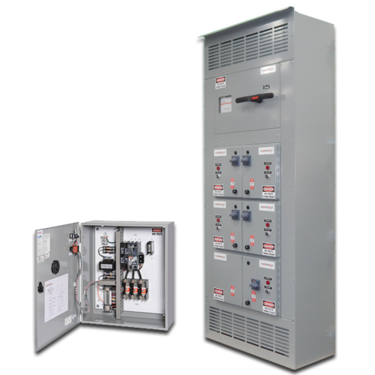
For use in fire safety and elevator control
Mersen’s Fusible Shunt Trip Switch is an all-in-one solution that meets many different code requirements with the protection and safety in elevator shafts. According to NFPA 13, 8.14.5, sprinkler protection is required at the top and bottom of elevator shafts. With that being said, NFPA 13 requires the installation of sprinklers in the elevator machine room. Once a sprinkler system has been introduced to either the elevator shaft or elevator machine room, you are now installing these per the State-Adopted Elevator Code ANSI/ASME A17.1.
To summarize ASME A17.1, Safety Code for Elevators and Escalators, Rule 102.2 (c) (3) requires the shutdown of power to the elevator prior to the application of water in the elevator machine room and or hoistway.
The shutdown of power is accomplished by a shunt trip device in the elevator circuit. This reduces the risk of any potential electrical shock once the water is released into the system. This will also reduce the risk of any elevator car slippage once the cables and hoist system become saturated from the release of water. In addition to turning off the power, 2002 NFPA 72 6.15.4.4 (Fire Alarm Code) requires:
“Control circuits to shut down elevator power shall be monitored for the presence of operating voltage. Loss of voltage to the control circuit for the disconnecting means shall cause a supervisory signal to be indicated at the control unit and required remote annunciation.”
This is achieved with the Fire Monitoring Relay (FR Relay), a standard feature in Mersen’s Fusible Shunt Trip Device. In the event of a power loss, at which point a back up power supply is introduced to the system, you are now required to meet NEC Article 620.91 paragraph (C) emergency or standby power system. This is accomplished with a set of mechanical interlock auxiliary contacts which comes standard as 1-N/O and 1-N/C contact. The auxiliary contacts prevent the elevator from descending down and injuring any workers that could be working in the elevator shaft. This also allows the elevator to move to the next convenient location and open the doors to let any passengers out in the event of an emergency.
- Shunt Trip Switch – Allows for tripping of the main line power via remote signal
- Fused Switch – Provides high current-limitation and short circuit withstand
- Padlockable Handle – Allows panel to be locked with switch in the off position ensuring load side power isolation during servicing
Applicable Codes and Standards:
- NFPA 13, 8.14.5
- NFPA 72 6.15.4.4
- ANSI/ASME A17.1
- cUL US Listed
Capabilities
An array of available options allows for maximum functionality to be built into a single compact panel. Panels built for elevator applications feature control transformers (fusing both primary and secondary sides), a fire safety interface relay with a fire alarm voltage monitoring relay, and mechanically interlocked auxiliary contacts. Use of Mersen’s Amp-Trap 2000® AJT Class J fuses permits easy selective coordination, while providing the panel and its components with superior current limitation and the ability to withstand high fault conditions. AJT fuses provide added system reliability since no maintenance or periodic testing is required as with other electromechanical overcurrent devices.
Fusible Shunt Trip Switch
- Primary Voltage (208, 240, 480 or 600 VAC)
- Standard voltage monitoring relay.
- Fire safety relay for control interface (3PDT Relay, choice of Coil Voltage: 120 VAC, 24 VDC or 24VAC)
- Oil-tight key switch to test 2 position selector switch
- Oil-tight power enabled indicator light (choice of colors: red, green or white)
- Isolated neutral lug – 100%. Oversized 200% for excessive Non-Linear loads
- Multiple options for auxiliary contacts and alarm contacts for indication. Handle activated microswitch is available for operation under test conditions.
- NEMA 12, 3R, 4 or 4X enclosure available
- DC Shunt Trip Switch Version Available – Consult Factory
Multi-Unit Fusible Shunt Trip Switch Panel:
- Top or Bottom Feed, Main Fused Switch (400, 600A, or 800A) or Main Lug Only (MLO)
- Branch ratings of 30A, 60A, 100A, 200A, and 400A branch frame sizes available. Unit can accommodate up to (6) shunt trip switches of 200A or below, or up to (3) 400A units, or combinations thereof.
- Standard Two Form C Auxiliary contacts.
Design Guide
datasheets, operation and maintenance manual.

In order to enjoy this content, you need to help yourself to some cookies first! Please use the link below to update your preferences.
Privacy settings
Mersen Fusible Shunt Trip Switch Video
Mersen's Fusible Shunt Trip Switch is an all-in-one solution for use in fire safety and elevator controls. Our new video describes how a shunt trip switch operates to protect elevators, emergency systems, and more,
Mersen’s reputation for outstanding technical expertise, product quality, and engineered safety is the result of over a century of design and manufacturing knowledge, coupled with state-of the-art equipment in three ISO-9001 registered facilities. Each facility manufactures single and multilayer bus bars, as well as fully integrated solutions in which the laminated bus bar also serves as a platform for a multitude of discreet components.
42.823086316295, -70.887182028602
Our N.A. Design center
Newburyport
374 Merrimac Street 01950 MA United States
How to Reset a Tripped Breaker
What to do when a circuit breaker trips.
Lee has over two decades of hands-on experience remodeling, fixing, and improving homes, and has been providing home improvement advice for over 13 years.
:max_bytes(150000):strip_icc():format(webp)/headshots_FINAL_lee-wallender-739d21a7b6ed4aa1b895c684e193494c.png)
The Spruce / Kevin Norris
What Causes a Tripped Circuit Breaker
Safety considerations, how to avoid tripped breakers, when to call a professional.
- Total Time: 5 mins
- Skill Level: Beginner
- Estimated Cost: $0
A power breaker trip is an annoying occurrence when the power shuts off and you can't use the microwave, lights, or router. A breaker trip is far more than simply annoying when you need that router to send off a time-sensitive work assignment or when medical devices are diverted to time-limited standby power. Fortunately, it's easy to fix a circuit breaker trip in just a few minutes.
Tripped Circuit Breaker
A tripped circuit breaker is when a circuit breaker automatically shuts off to prevent devices on the circuit from overheating or from receiving excessive power. A circuit breaker protects your home against damaging or harmful short circuits and overloads.
- Overloaded circuits : When too many devices are operating on the same circuit and are attempting to pull a higher power load than the circuit can carry, the circuit breaker will trip.
- High-power devices : High amp devices like microwaves , dryers , wall heaters , or A/Cs are turned on for sustained periods, they can cause a power breaker trip.
- Short circuits : In a short circuit, a powered or hot wire makes contact with a neutral wire or when wires are loosened .
- Ground faults: In a ground fault, a hot wire touches anything that is grounded, such as the side of a metal electrical box , an appliance, an outlet , or a bare ground wire.
Need more help? Talk to an electrician near you
Our partners can help you compare quotes from top-rated professionals near you
Get a Quote
Watch Now: How to Safely Reset a Tripped Circuit Breaker
Working around an electrical service panel or circuit breaker board can be dangerous. Your home’s entire electrical load is contained in that box, concentrated around the metal lugs where the service drop’s wires enter the box. Unscrewing and removing the inner dead-front cover within the service panel exposes the highly powered lugs.
What You'll Need
Equipment / tools.
- Circuit breaker directory (if available)
- Rubber-soled shoes
- Safety glasses
Instructions
Locate a flashlight.
Circuit breaker panels tend to be located in out-of-the-way locations with little, if any, ambient light. Find a flashlight. Use the light from a phone if necessary.
Turn Off Devices on the Circuit
Turn off all devices on the electrical circuit. This includes the device that may have caused the breaker to trip, such as a microwave, hairdryer, or A/C, plus all other devices on the same circuit.
Find the Electric Service Panel
The electric service panel, sometimes called a circuit breaker board, is a metal box with a door. The box may be inset in a wall, its face flush with the wall, or surface-mounted where the entire box is exposed.
Places to look: garage , closet, pantry near the kitchen, basement , mudroom, hallway leading to garage or backyard.
One clue is to first find the electric service drop from the main power lines. Usually, your home’s service panel is located below and nearby, on the inside of your home.
Open the Door to the Service Panel
Open the door to the service panel by sliding the plastic switch to the side or up. Next, swing the door open. Use the inset plastic switch as a handle to pull the door open.
Adhi Syailendra / Getty Images
Locate Tripped Breaker
The handle of a tripped circuit breaker should be in the middle position—not left or right. Visually or by feel, locate any breaker handles that differ from the right or left positions:
- Tripped breakers : Tripped circuit breakers have a soft or springy feeling when you lightly press them leftward or rightward.
- Live/active breakers : Breakers that are not tripped are either firmly left or right (depending on which side of the box you're looking at).
Certain breakers, such as Eaton breakers , trip to the off position, not the middle position. Check manufacturer's instructions for your particular product.
Turn the Circuit Breaker Handle to OFF Position
Flip the circuit breaker handle to its firm OFF position, toward the outer edge of the service panel (away from the centerline).
Double and Tandem Breakers
Double pole breakers are double-wide breakers with wide handles. They are often used for dryer or oven circuits. Both sides of double pole breakers operate as one. Tandem breakers are two narrow breakers that share the space of one breaker. Each side operates individually.
Turn the Circuit Breaker Handle to ON Position
Flip the circuit breaker handle to its firm ON position, toward the centerline of the service panel. The handle should seat firmly in place and should make an audible click.
Test Circuit
Turn the device such as the light or A/C back on. If you believe the breaker tripped due to an overload, it’s best to turn on only one device at this time, not multiple devices. Also, choose a device with a lower power draw such as a light fixture.
- Remove some devices from the overloaded circuit and plug them into other circuits that aren’t drawing as much power.
- Avoid running many devices on the circuit at the same time. In a kitchen , for example, stage cooking activities that require power so that they happen in succession, not all at once.
- Install GFCI outlets so that the outlet shuts off before the entire circuit breaker shuts down in the case of a ground circuit. Just note that GFCI outlets are not circuit overload protection, but protection against dangerous ground faults.
- Replace old outlets, light fixtures, and switches which may create short circuits or trip breakers.
- Have an electrician separate hardwired devices that are drawing too much power from a single circuit. The electrician can move devices to another circuit or can set up an entirely new circuit to relieve the load.
- Replace the circuit breaker.
A qualified, licensed electrician is trained to detect the cause of tripped breakers and to fix those causes. If your problem of tripped circuit breakers is more than just an overloaded circuit, you may want to seek the help of an electrician. Unless you are an advanced do-it-yourselfer , it’s best to hire an electrician to wire up a new circuit breaker .
Electrical Panel Safety . Office of Congressional Workplace Rights.
CH Circuit Breakers . Eaton.
Ground-Fault Circuit Interruptors . International Association of Certified Home Inspectors.
More from The Spruce
- How Much Does It Really Cost to Replace an Electrical Panel?
- GFCI Receptacle vs. GFCI Circuit Breaker
- How to Replace an Electrical Outlet: A Beginner's Guide
- Calculating Electrical Load Capacity for a Home
- Ground Fault vs Short Circuit: What's the Difference?
- Line vs. Load Wiring: What's the Difference?
- How to Reset a Circuit Breaker
- A Basic Guide to Home Electrical Wiring
- How Much Does an Electrician Really Cost? We Break It Down by Service
- What Happens When a Fuse Blows
- Understanding Arc Faults and AFCI Protection
- Subpanels Explained for Home Owners
- Understanding Fuses and Fuse Boxes
- How to Wire a Single-Pole Light Switch
- What Is a Short Circuit, and What Causes One?
- Amps vs. Volts: The Dangers of Electrical Shock
- Your Local Electrician 0151 351 4011
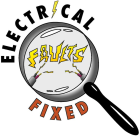
- Consumer Unit Upgrade
- Electrical Safety Checks
- Electrical Emergency
- Electrician in Warrington
- Security lighting
- Areas we cover
- Knowledge Centre
- Helpsheets / Downloads
- Meet the team
- Social media
- Electric Heating Calculator
- Socket overload calculator
- Google Search Questions
Trip Switch On Fuse Box Won’t Stay Up
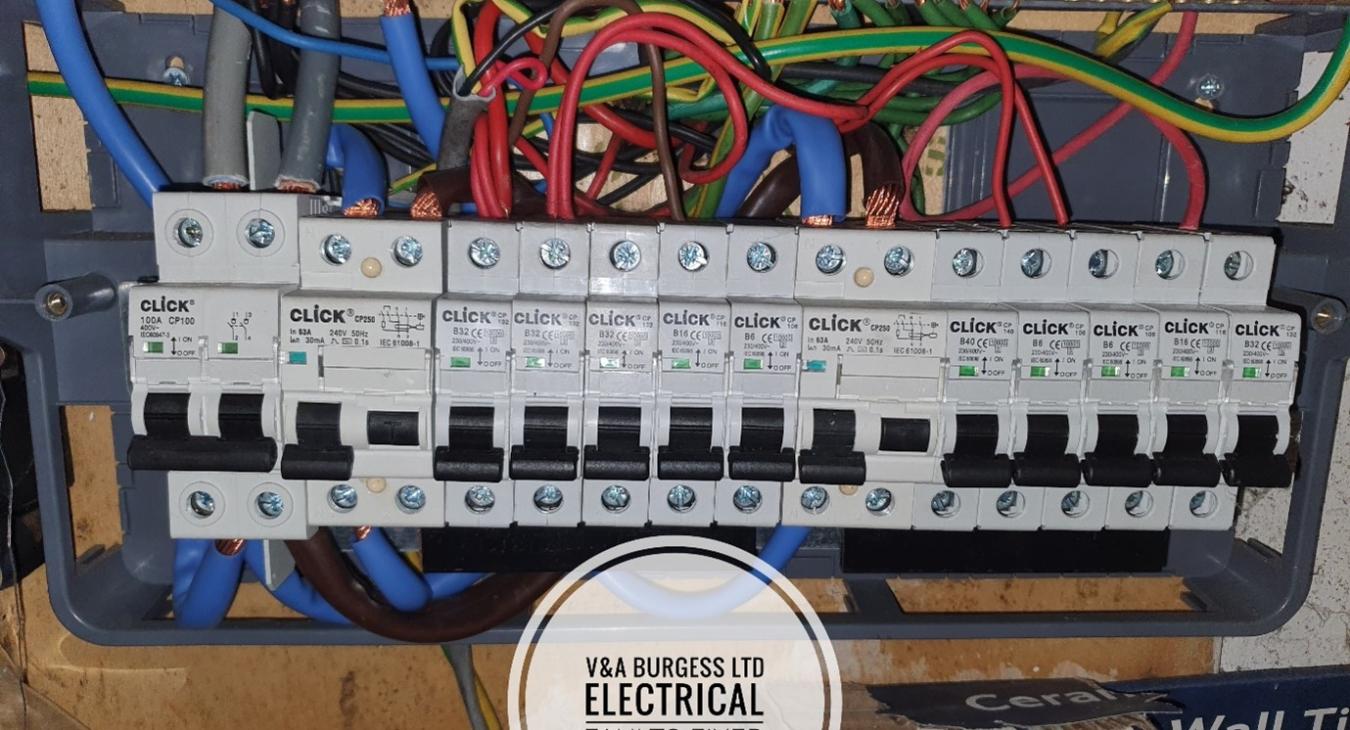
In our homes, there is a box that contains the gubbins for our homes electrical system.
This box has lots of wires and devices inside that control and monitor our homes electrical system to keep us safe. .
In older properties with older electrical systems the box is often smaller and contains fuses or fuse wire devices.
The box pictured above is a modern “consumer unit” which has ‘trip switches’ rather than fuses of or fuse wire devices.
The older fuse box style boxes would blow a fuse or fuse wire when there was an electrical problem. This would then need to be replaced or re-wired in order to get the circuit back on and in some cases it would blow again immediately requiring investigation by an electrician to find out the cause.
Modern style consumer units have these ‘trip switches’ which trip off when they detect a fault rather than blowing a wire or a fuse. The advantage of these more modern units is that they can easily be reset after a fault, they contain safer devices to protect us and offer much better electric shock protection for the whole property in general.
When a trip switch on fuse box won’t stay up there is generally a problem that needs to be investigated by an electrician. If the switch has gone off then resetting it more than once is asking for trouble. What does a trip switch do?
Different trip switches do different things but they are all there to protect the electrical installation and its users from harm. When a trip switch trips it has to get rid of the fault that has been generated. This involves safely disposing of an electrical fault current that is very large. The trip switches are designed to do this safely and without damage HOWEVER, asking a trip switch to dispose of this large fault current over and over can have consequences. These switches are designed to do this very rarely and not every 5 minutes all weekend!!
If you have a trip switch that is constantly tripping then it is VITAL that you have an electrician out to look at the causes for this.
What do the different trip switches do?
There are a number of different trip switches that may be in the consumer unit. These are as follows:
Each of these trip switches performs slightly different functions and some do the same job.
- An MCB of Miniature Circuit Breaker, is a device that will trip under two circumstances. When there is a fault involving a very high current flow in a circuit such as a nail through a cable touching line and earth wires together and when there is a gradual and prolonged overload such as lots of appliances being used at the same time. These devices offer protection to the cables in the home but no electric shock protection.
- An RCD or Residual Current Device is effectively an electrical balancing scales. It monitors electrical current flow in a circuit and will trip if it detects any current missing. The assumption is that the missing current is flowing through a human body! These devices are much more sensitive to tripping that other protective devices although they offer no protection for overload in a circuit.
- An RCBO is very clever indeed! It is an MCB and and RCD all in one. These perform both functions and will trip in lots of different circumstances. They are also massively more convenient if there is ever a fault in your home as you won’t lose lots of things all at once. If there is a fault on the cooker circuit then JUST THAT CIRCUIT will go off.
- RCCB a Residual Current Circuit Breaker is effectively just another RCD device.
- AFDD is an Arc Fault Protection Device. These are an MCB, an RCD and fire protection all in one device. At the time of writing, they are relatively expensive and can mean a new fuse board can costs a few thousand pounds. The devices are coming down in price and we hope to be fitting them as standard as soon as they are more affordable.
You can see that if your “TRIP ON FUSE BOX WON’T STAY UP” then there can be a lot of different switches and different reasons for this. It is not always possible to reset these things yourself and constant resetting of a switch will eventually break it! Its best to have these things checked out before they become expensive problems.
Is there anything I can do myself?
Yes actually there is. We are really nice people 😊 and we have written a help sheet just for you, to try to save you money, time and aggravation. The help sheet will go through the issues step by step to enable you, in some cases, to restore power and possibly find the cause without our intervention.
The help sheet is here: https://www.electricalfaultsfixed.co.uk/helpsheet/help-my-house-electrics-are-tripping
We hope that it helps you find the answers to your problems. If you are still having problems then it will be necessary for us to come out and help you in your home.
When can you come out?
If you require us to attend then we will normally request the first hours labor via credit or debit card / BACS before we head over. We often have to leave a job, load a van in the middle of the night and so on before coming over to you so please ensure that you wish us to attend and are happy for us to do this. We can take calls for emergencies and attend emergencies 24 /7. Telephone advice and quote enquiries are only available during working hours however. For more information, contact us today.
Always know what you are paying for!
Call us today on 0151 351 4011 for a free, no obligation, quotation for your project. your call matters to us, and we will respond..
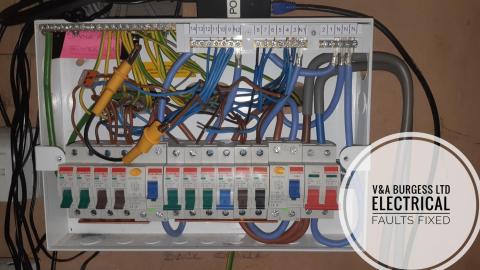
Emergency Electrician
I am a specialist in electrical emergency works. This means I can be with you quickly and fix your electrical problems efficiently to get your power back on as soon as possible. Here you will find all the information you may need to make an informed decision on finding the right Electrician in Liverpool for you.
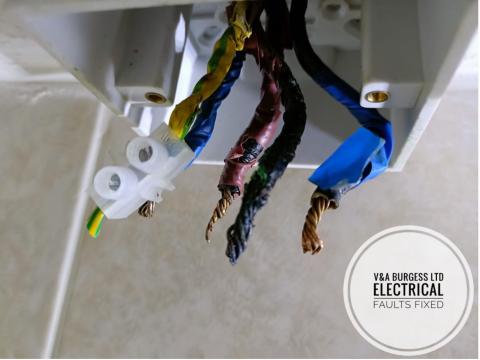
Electrical Fault Finding
I am a specialist in electrical fault finding. This means I can quickly and efficiently find the issue with your electrical system to get your power back on as soon as possible. Here you will find all the information you may need to make an informed decision on finding the right Electrician in Liverpool for you.

An emergency electrician in Liverpool you can trust
What are trip switches and where can I find them?

Trip switches work as an electrical device in your home or property. You can find your trip switches on your consumer unit (sometimes called fuse box). They are usually in the garage, hallway, kitchen, utility room, lavatory or under the stairs.
Some homes, (generally those with older wiring) will have rewireable fuses instead of trip switches. If there is a fault with your wiring or one of your electrical appliances, trip switches will turn off the power to the circuit the fault is on. It will remain off until the fault is fixed, although once a faulty appliance is unplugged, you can try switching the trip switches back on.
Watch our video for more information.
Where to find your trip switches

Trip switches are normally located near the electricity meter

Trip switches will operate when there is a fault on the internal circuit
You may also be interested in:
- Need to pay electricity bills or replace lost meter keys
- What is 105?
- Power cut help and advice
- I don't have electricity, is there a problem with my electricity meter?
- Why is your telephone number on my bill?
Free to call from a mobile or landline phones. Lines are open 24 hours a day.

IMAGES
VIDEO
COMMENTS
Your fuse box, or consumer unit, will either have fuses or trip switches. Modern electric circuits are fitted with a circuit breaker fuse system; if a fault develops, a switch is tripped and the circuit is broken. Older ones have fuse holders and when a fuse is blown it must be replaced or rewired.
About Press Copyright Contact us Creators Advertise Developers Terms Privacy Policy & Safety How YouTube works Test new features NFL Sunday Ticket Press Copyright ...
This video will show you how to reset a tripped circuit breaker switch on a fuse box panel, and what to look for if they are not labeled.DisclaimerOur videos...
Reset the Tripped Breaker. To reset the breaker, move the switch into the "on" position to restore power. If the breaker switch is in the middle position, you should first move it to the "off" position before flipping it back up to "on.". Occasionally, a breaker box can spark when you reset a switch.
Unplug or turn off the appliances or devices that are connected to the tripped circuit. To determine which appliance or device is causing your electricity to trip, you can unplug each one so you can find which one is causing the problem. 3. Reset the circuit breaker. Once you've unplugged all of your appliances you can then switch the fuse ...
Locate the circuit breaker that was tripped. Circuit breaker switches either have two or three settings. Those with two settings will either be switched on or off. Those with three settings have an "on," "off" and "neutral" (center) position. If the tripped breaker is in the "off" position, switch it to the "on" position.
To determine this: Unplug all of your appliances and try resetting the fuse switch. Once reset, plug your appliances back in one at a time and switch them back on. If the switch trips again, you'll know it's the last appliance that you plugged in and switched on. Turn off and unplug the appliance, before resetting the switch.
Your fuse box will have either fuses or trip switches. If a fuse "blows" then you will have to replace it in order to regain power. Trip switches are a more modern alternative to fuses. Rather than the fuse physically breaking, the switch is tripped and the power circuit goes from "on" to "off". Reset the trip switch
Identify the Problem: Examine your fuse box to determine whether it contains fuses or trip switches. In modern installations, trip switches are often used. A tripped switch shifts the power circuit from the "on" position to the "off" position. Reset the Trip Switch: If you have trip switches, it's relatively easy to identify the problem. The ...
When they 'trip', you can simply reset the switch. But make sure you correct the fault first. Fuses (may be found in place of circuit breakers) - rewirable fuses have a piece of special fuse wire running between two screws. When a fault or overload current flows through the fuse wire, it will become hot and melt.
Locate your circuit breaker box and open the cover. Once you've located the tripped breaker, flip it to the "Off" position. Then, flip it back to the "On" position. You should hear a click as the breaker resets. If the breaker trips again, or simply won't reset, there may be a problem with your wiring.
To fix a tripped fuse on an old fuse box, Turn off the power source. Take out the blown fuse and insert a replacement. Then switch the power back on. To find the right replacement it is best you send the blown fuse along when getting a new one if you don't understand much about electrical writings. Tip: If a fuse or switch trips, unplug some ...
You think that the circuit breaker has tripped, so you head to the electrical panel to reset the breaker. You push the tripped switch into the off position, then back up into the on position to reset it. But the switch won't stay in the on position, and the circuit breaker won't reset. Or it resets but trips again immediately.
The first step in fixing a tripped fuse is identifying the problem. When a fuse trips, it's typically due to an overload or short circuit in the electrical system. Start by locating your fuse box, usually found in the basement, garage, or utility room. Open the fuse box, and you'll see a series of on-off switches known as circuit breakers.
Find out the cost to replace an electrical panel. On every breaker, there will be an "On" and "Off" position. On a tripped breaker, the handle will be in the middle, neither On nor Off. To reset, flip the handle to Off first, then to On. Stand to the side of the panel and turn your face away when flipping breakers.
A tripped fuse box can occur at the most inconvenient moments. Fuses are a safety measure used in electric circuits. If there's an electrical fault or excessive current flow, the fuse will break the circuit, causing your power to go out. ... Today, most homes have trip switch fuse boxes installed with electrical fuse breakers. These switches ...
A sudden loss of electricity can happen if your fuse box has tripped. Your main trip switch might have turned off all your electricity; or it could be that an individual circuit has gone off. You can usually fix this yourself by opening the fuse box and flicking a switch back to the 'on' or 'green' position. But please only do this if ...
Please support my content creation by using my Amazon Store:http://astore.amazon.com/m0711-20----- Click "Show more" -----...
Devices charging slowly. Electrical outlets not working. Flickering lights. Scorch marks on outlets and light switches. If a circuit breaker keeps tripping in one room, homeowners can test for ...
Shunt Trip Switch - Allows for tripping of the main line power via remote signal; Fused Switch - Provides high current-limitation and short circuit withstand; Padlockable Handle - Allows panel to be locked with switch in the off position ensuring load side power isolation during servicing; Applicable Codes and Standards: NFPA 13, 8.14.5
What Causes a Tripped Circuit Breaker . Overloaded circuits: When too many devices are operating on the same circuit and are attempting to pull a higher power load than the circuit can carry, the circuit breaker will trip.; High-power devices: High amp devices like microwaves, dryers, wall heaters, or A/Cs are turned on for sustained periods, they can cause a power breaker trip.
In older properties with older electrical systems the box is often smaller and contains fuses or fuse wire devices. The box pictured above is a modern "consumer unit" which has 'trip switches' rather than fuses of or fuse wire devices. The older fuse box style boxes would blow a fuse or fuse wire when there was an electrical problem.
Trip switches work as an electrical device in your home or property. You can find your trip switches on your consumer unit (sometimes called fuse box). They are usually in the garage, hallway, kitchen, utility room, lavatory or under the stairs. Some homes, (generally those with older wiring) will have rewireable fuses instead of trip switches.